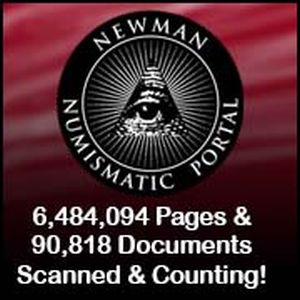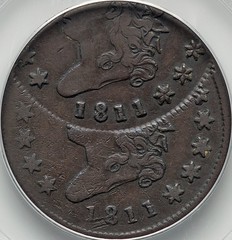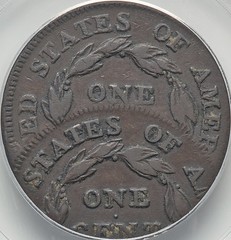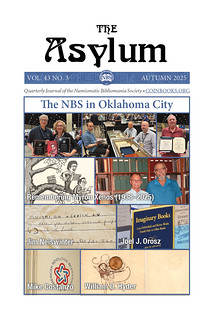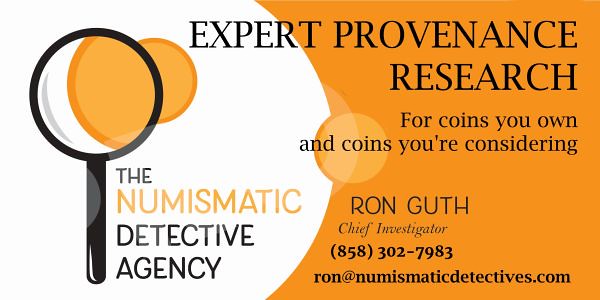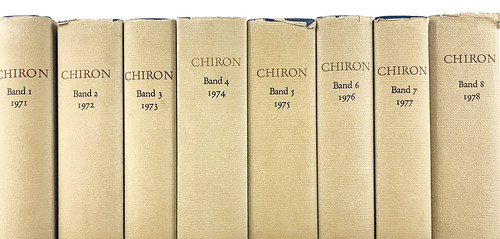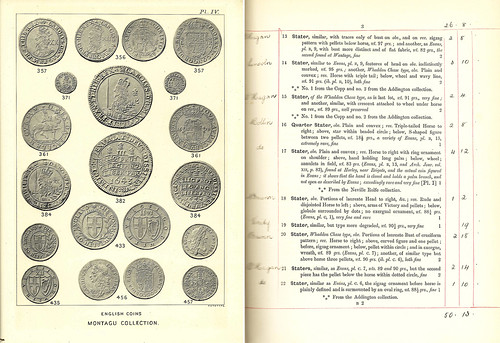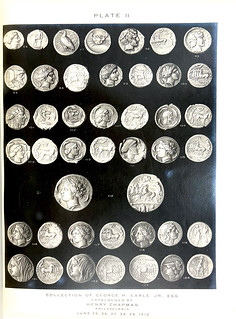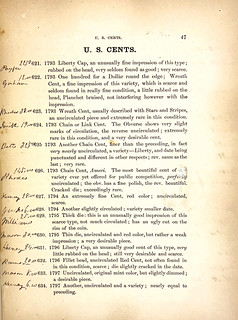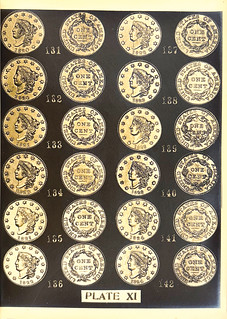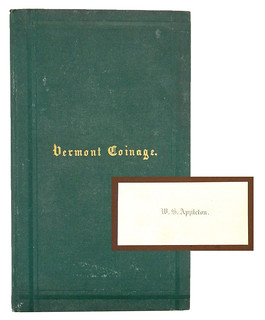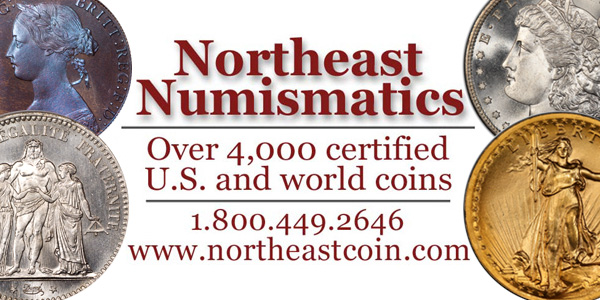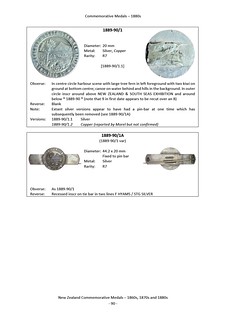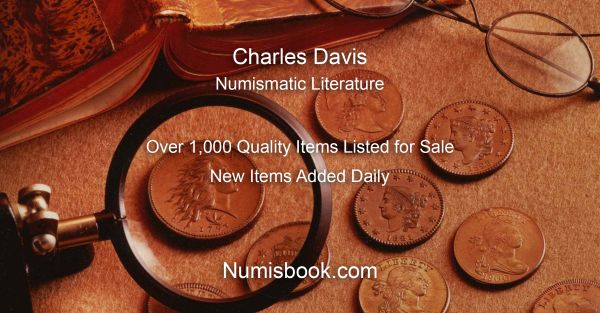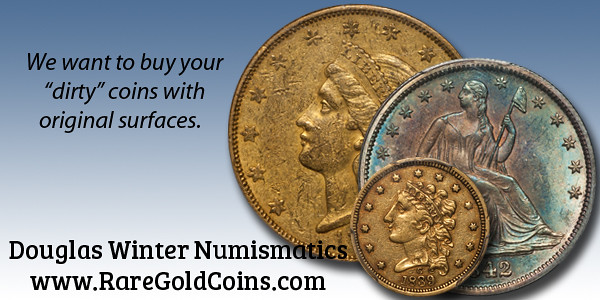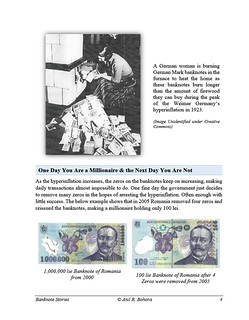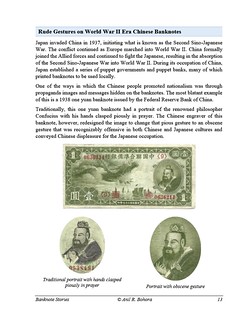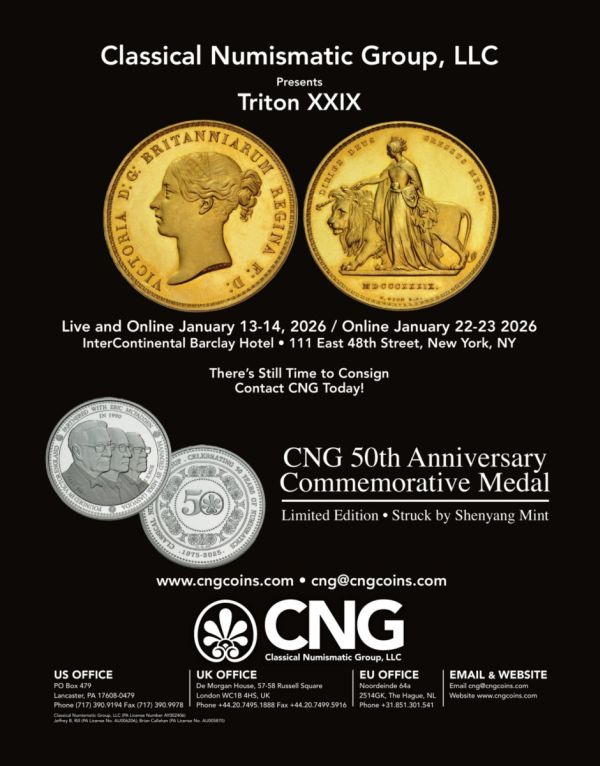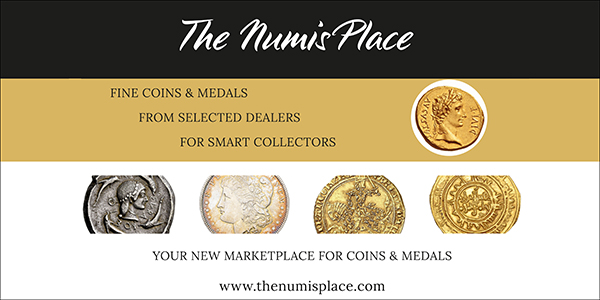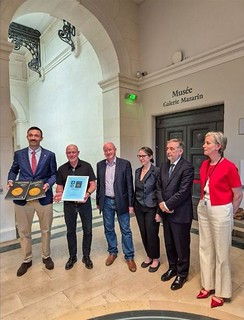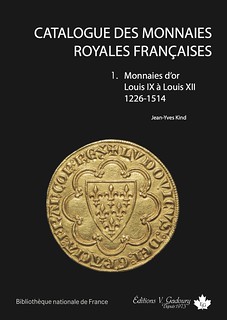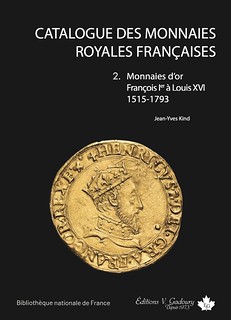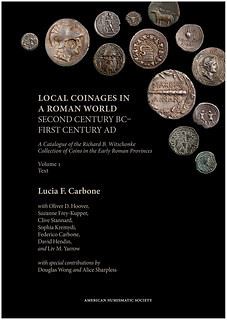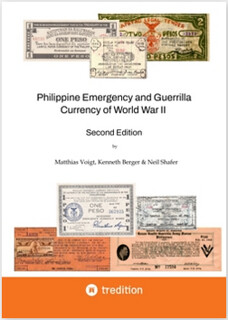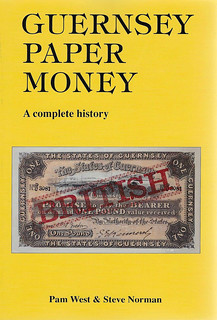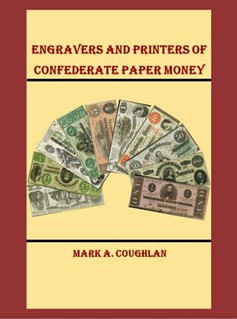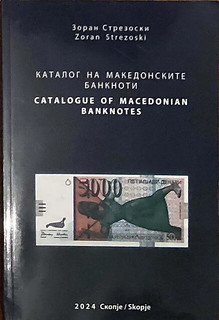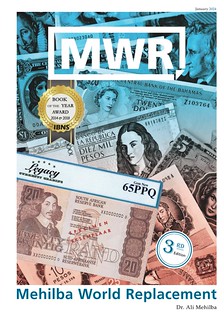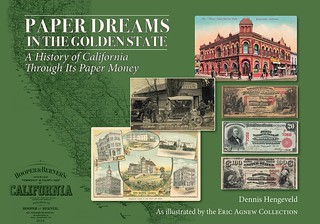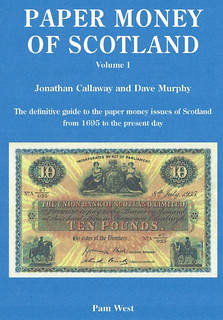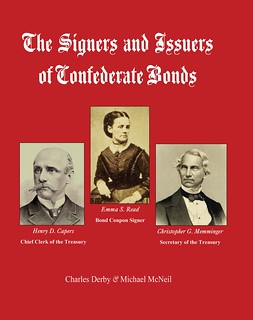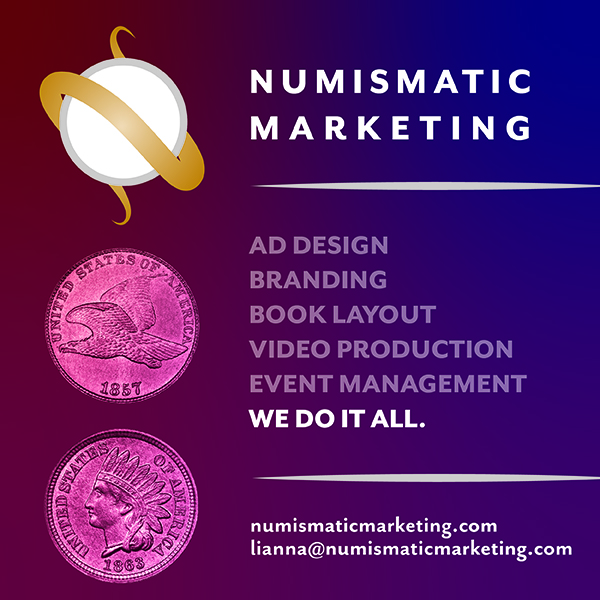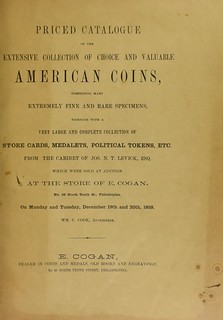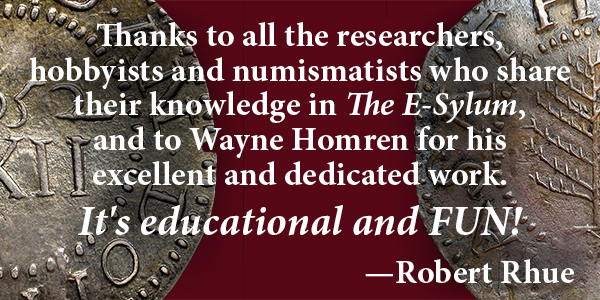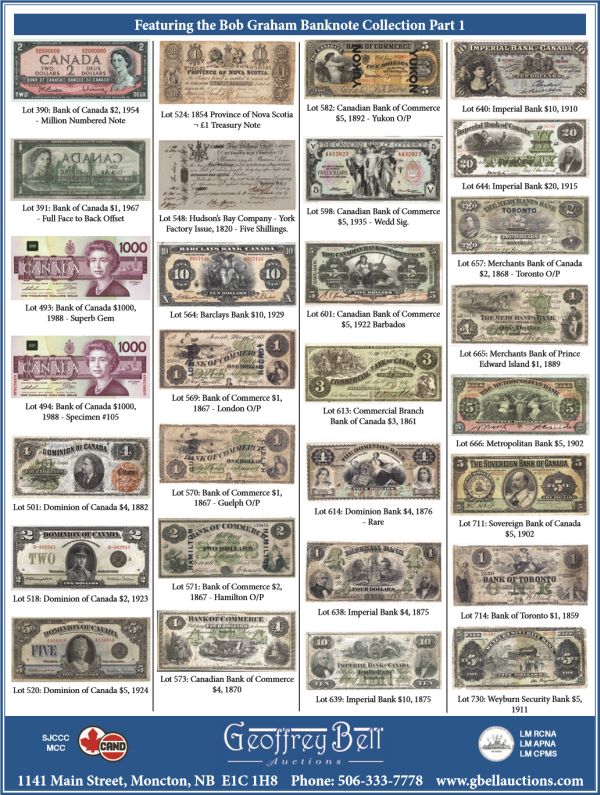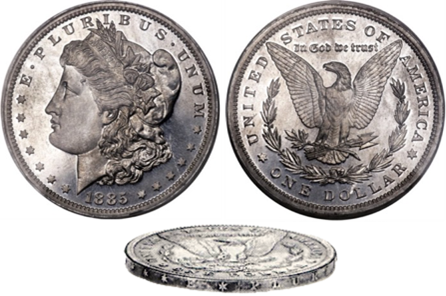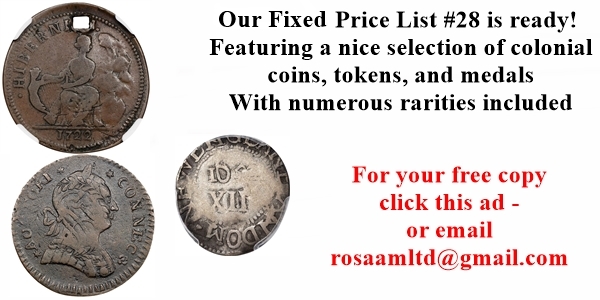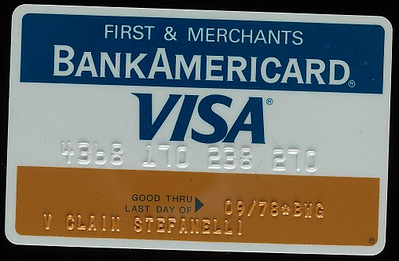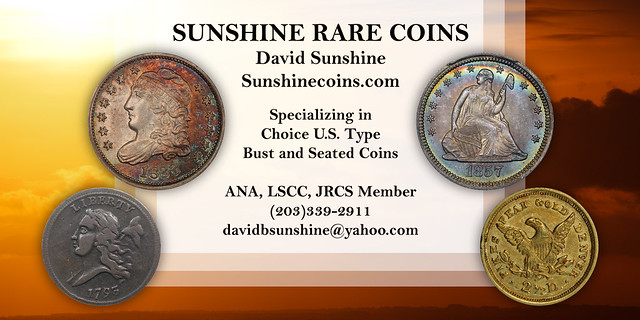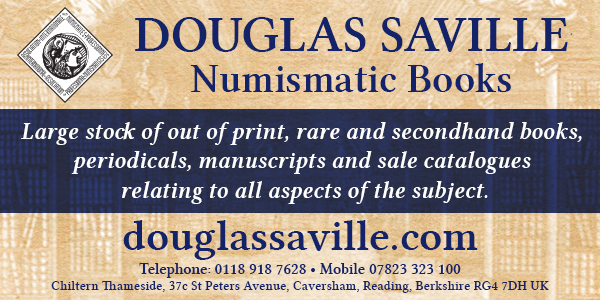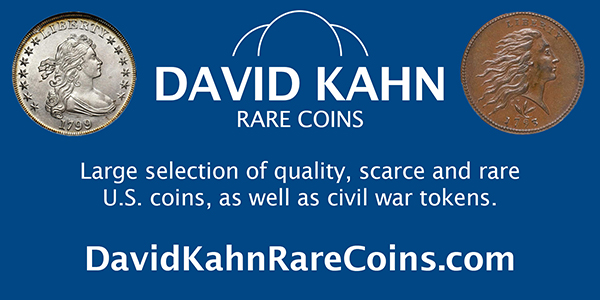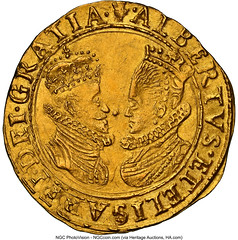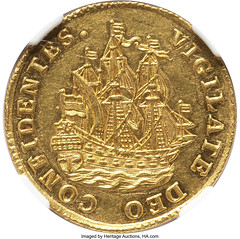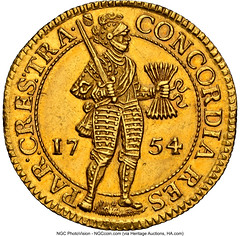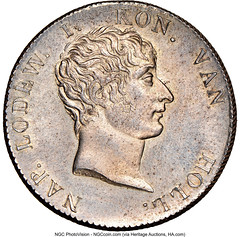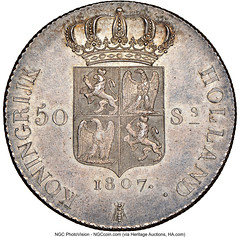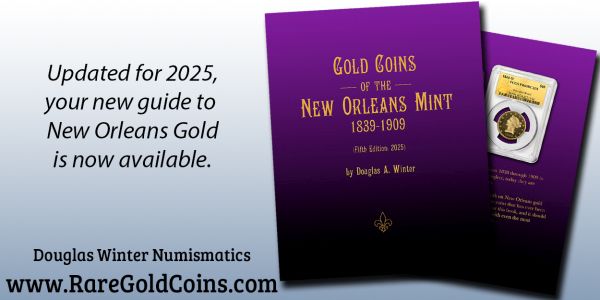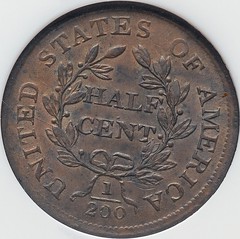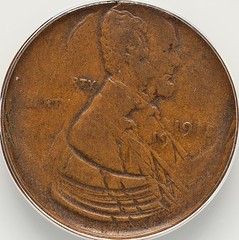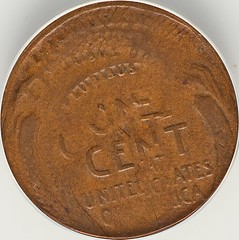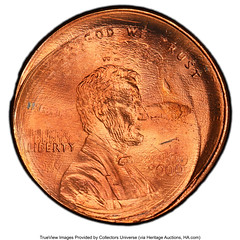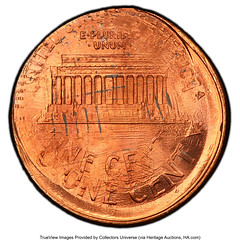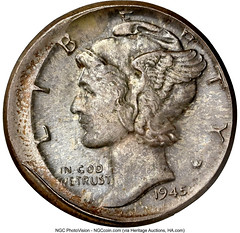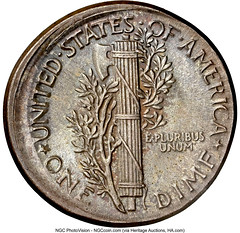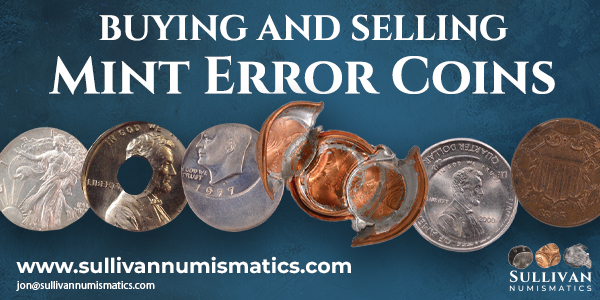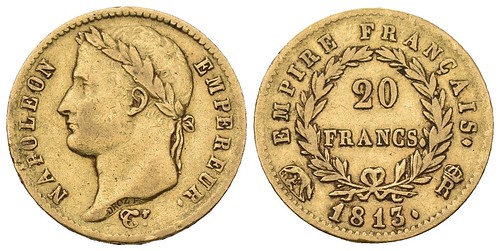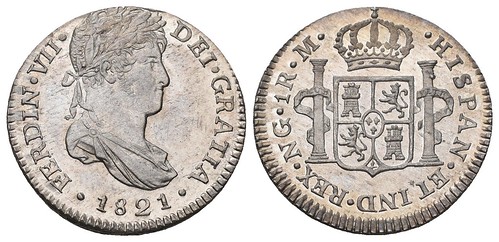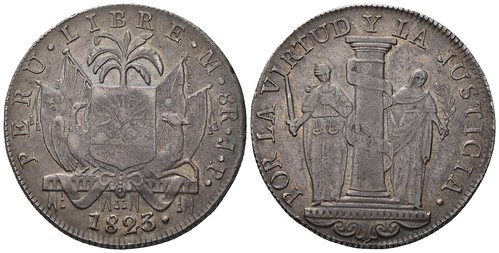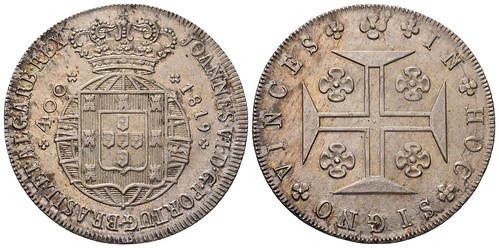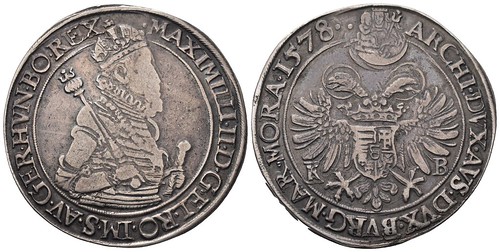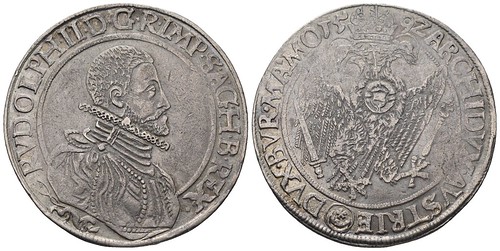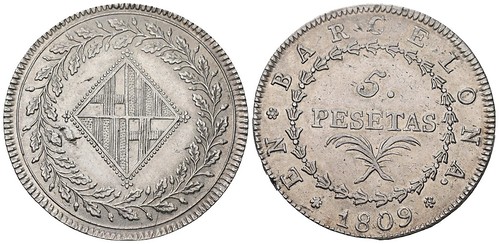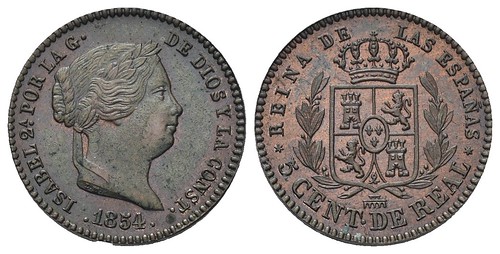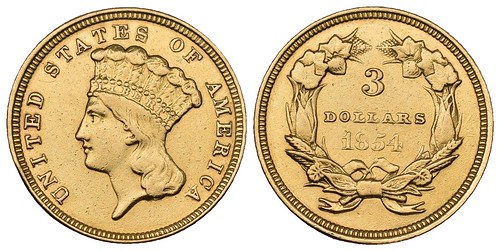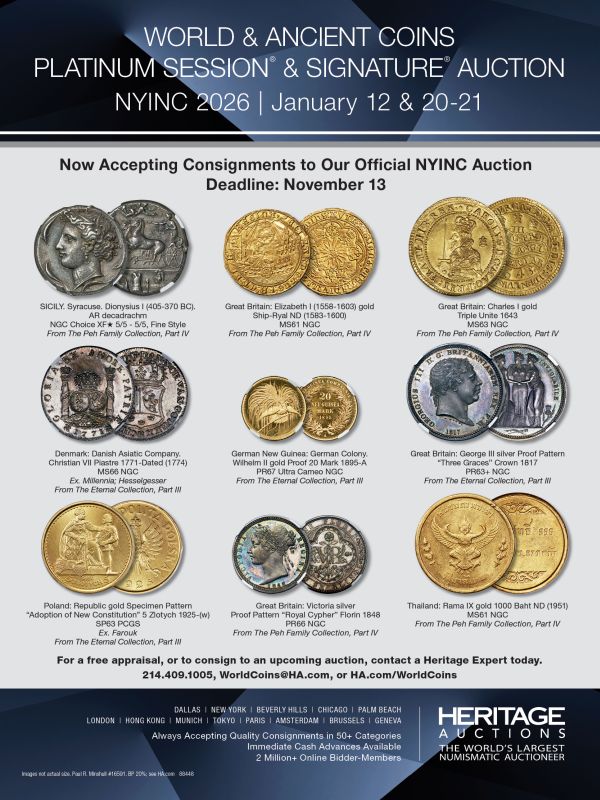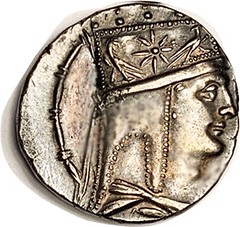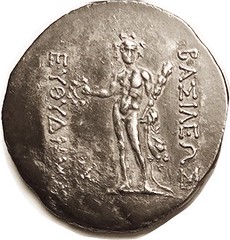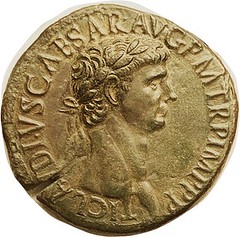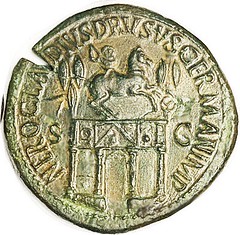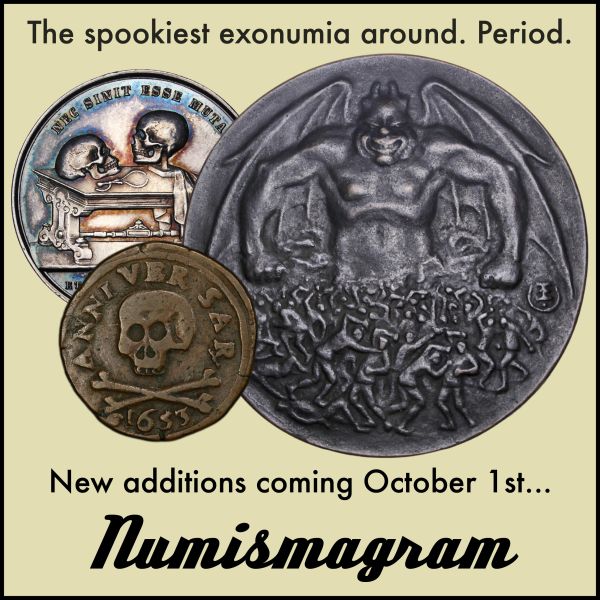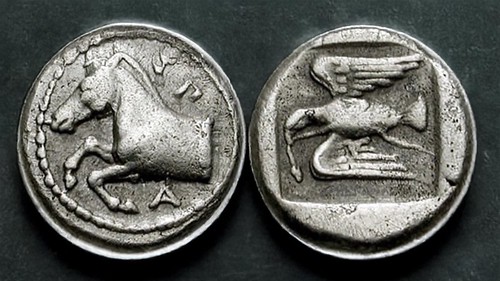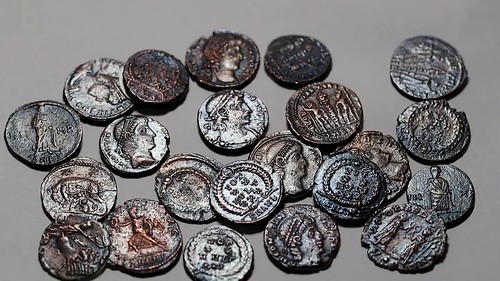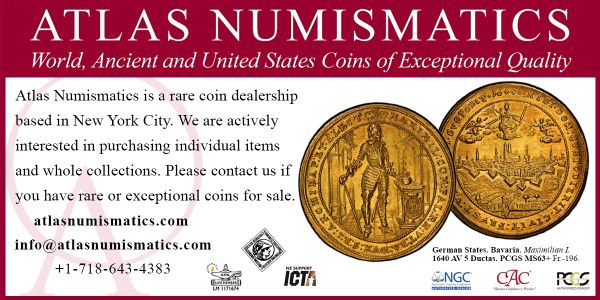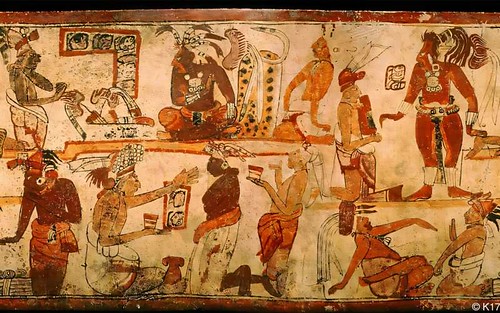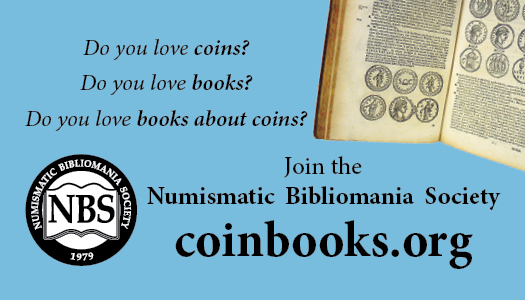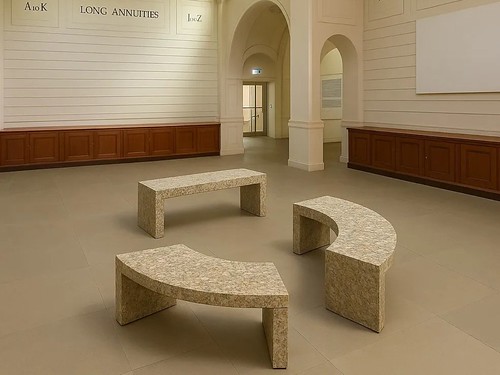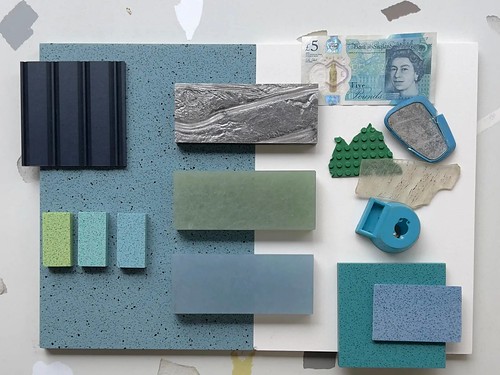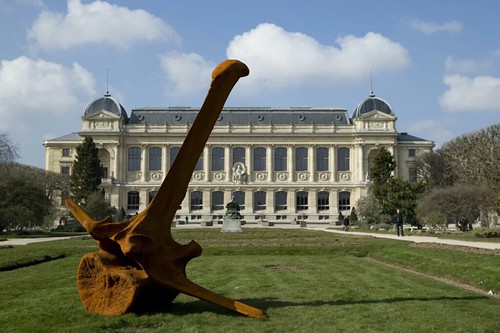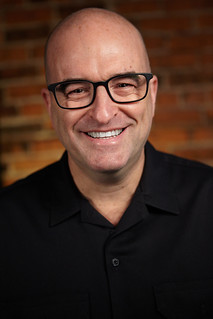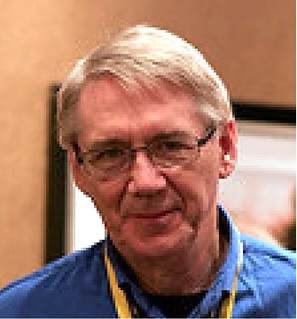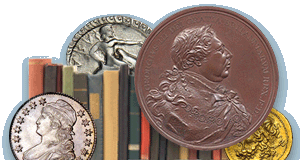
Visit our NBS Sponsors
About UsThe Numismatic Bibliomania Society is a non-profit association devoted to the study and enjoyment of numismatic literature. For more information please see our web site at coinbooks.org SubscriptionsThose wishing to become new E-Sylum subscribers can go to the following web page
Subscribe
MembershipThere is a membership application available on the web site Membership Application To join, print the application and return it with your check to the address printed on the application. Print/Digital membership is $40 to addresses in the U.S., and $60 elsewhere. A digital-only membership is available for $25. For those without web access, write to: Jeff Dickerson, Treasurer AsylumFor Asylum mailing address changes and other membership questions, contact Jeff at this email address: treasurer@coinbooks.org SubmissionsTo submit items for publication in The E-Sylum, write to the Editor at this address: whomren@gmail.com BUY THE BOOK BEFORE THE COINSale Calendar |
- WAYNE'S WORDS: THE E-SYLUM SEPTEMBER 28, 2025
- ASYLUM AUTUMN 2025 ISSUE PUBLISHED
- KOLBE & FANNING OCTOBER 2025 SALE SELECTIONS
- NEW BOOK: ALEXANDREIA TROAS COINAGE
- NEW CHAPTER: NEW ZEALAND MEDALS 1860S-80S
- NEW BOOK: BANKNOTE STORIES
- NEW BOOKS: THE ALMIGHTIER, MAKING MONEY WORK
- BOOK REVIEW: THE ROMAN PROVINCES, 300 BCE–300 CE
- 2025 IAPN BOOK PRIZES AWARDED
- 2024 IBNS BOOK OF THE YEAR RESULTS
- COGAN LEVICK SALE CATALOG EDITIONS
- VIDEO: PNG LIVING HISTORY: Q. DAVID BOWERS
- BREEN, BASHLOW, SHELDON AND THE X-FILES
- MORE ON THE 16TH 1804 DOLLAR PROVENANCE
- NOTES FROM E-SYLUM READERS: SEPTEMBER 28, 2025
- 2025 ANA PHILANTHROPY AWARD
- THE 2025 NATIONAL STOCK CERTIFICATE SHOW
- VOCABULARY TERM: ROLLING MILL
- IVAN CHARLES MICHELS (1829-1906)
- HERITAGE: NETHERLANDS AND DUTCH COLONIES
- HERITAGE: ERROR US COINS SHOWCASE
- GUT-LYNT AUCTION 22 COIN SELECTIONS II
- FRANK ROBINSON 129TH AUCTION ANCIENTS
- COINS OF THRACE'S WARRIOR KINGS
- COIN FINDS IN GALILEE
- TALLY STICKS AND THE ORIGIN OF MONEY
- WAMPUM BEADS UNEARTHED IN NEWFOUNDLAND
- LONDON DESIGN FESTIVAL BANKNOTE BENCHES
- THIEVES STEAL GOLD FROM MUSEUMS
- LOOSE CHANGE: SEPTEMBER 28, 2025
- FEATURED WEBSITE: COINS & HISTORY FOUNDATION
- ABOUT THIS ISSUE: SEPTEMBER 28, 2025
Content presented in The E-Sylum is not necessarily researched or independently fact-checked, and views expressed do not necessarily represent those of the Numismatic Bibliomania Society.
WAYNE'S WORDS: THE E-SYLUM SEPTEMBER 28, 2025
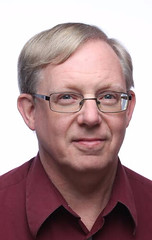 New subscribers this week include:
B. Washburn.
Welcome aboard! We now have 6,851 subscribers.
New subscribers this week include:
B. Washburn.
Welcome aboard! We now have 6,851 subscribers.
Thank you for reading The E-Sylum. If you enjoy it, please send me the email addresses of friends you think may enjoy it as well and I'll send them a subscription. Contact me at whomren@gmail.com anytime regarding your subscription, or questions, comments or suggestions about our content.
This week we open with a new Asylum issue, more Kolbe & Fanning sale numismatic literature, five new books, a review, multiple book awards, updates from the Newman Numismatic Portal, and more.
Other topics this week include banknote stories, Dave Bowers, Walter Breen, Robert Bashlow, the 1859 the J.N.T. Levick auction sale, stock certificates, rolling mills, auction previews, coin finds in Galilee, tally sticks, wampum beads, and museum thefts.
To learn more about Myron Xenos, the IAPN and IBNS book prizes, the Columbia superkids project, author Ivan Charles Michels, the Similar Sixpence Scandal of 1887, embarrassingly drunk Senators, Bulgarian numismatists, the Israel Numismatic Research Journal, the "Regnbuetræffet" at Christiania Medal, and the only convicted forger depicted on a banknote, read on. Have a great week, everyone!
Wayne Homren
Editor, The E-Sylum
ASYLUM AUTUMN 2025 ISSUE PUBLISHED
The Autumn 2025 issue of The Asylum is on the way from our sponsor, the Numismatic Bibliomania Society. -Editor
Welcome to The Asylum's Autumn 2025 edition.
- NBS 2025 Charity Auction Report
- NBS Treasurer's Report
- NBS Annual Meetings, Symposium, and Charity Auction NBS at the ANA in OKC
- ANA Numismatic Literature Exhibit Awards By Leonard Augsburger
- Remembering Myron Xenos (August 3, 1938 to July 20, 2025) By Thomas D. Harrison
- Memories of Myron By Joel J. Orosz
- Original Varieties of Levick's Plate of 1793 Cents By Jim Neiswinter
- Five Imaginary Nineteenth-Century American Numismatic Books By Joel J. Orosz
- Fifty Years Later: The Bicentennial of the United States. A Final Report to the People. By Mike Costanzo
- Elder's 1908 ANA Dinner Invitation By William D. Hyder
Remember, while The E-Sylum is free to all, only paid members of the Numismatic Bibliomania Society receive our print journal, The Asylum. Print/Digital membership is $45 to addresses in the U.S., and $65 elsewhere. A digital-only membership is available for just $25. -Editor
To join NBS or renew your membership, see:
https://www.coinbooks.org/about/membership.html
KOLBE & FANNING OCTOBER 2025 SALE SELECTIONS
Here are more selections for the upcoming October 4, 2025 Kolbe & Fanning numismatic literature sale. -Editor
 Kolbe & Fanning Numismatic Booksellers will be holding our next auction sale on Saturday, October 4, 2025. Sale 174 features an eclectic selection of rare and out-of-print works on ancient, world and U.S. numismatics, the property of over twenty different consignors from around the world. The wide variety of material to be found in the 500 lots comprising the sale means that there is something for everybody.
Kolbe & Fanning Numismatic Booksellers will be holding our next auction sale on Saturday, October 4, 2025. Sale 174 features an eclectic selection of rare and out-of-print works on ancient, world and U.S. numismatics, the property of over twenty different consignors from around the world. The wide variety of material to be found in the 500 lots comprising the sale means that there is something for everybody.
Some highlights of this first sale include:
Lot 49: an extensive run of the German Archaeological Institute's periodical Chiron, with numismatic contributions by a number of important scholars
Lot 177: a priced and named copy of Sotheby & Son's 1832 auction catalogue of the Marmaduke Trattle collection of ancient and British coins and medals, with a letter from Trattle laid in
Lot 205: the first four parts of the first major corpus of Russian medals, complete for the Imperial medals, published by the Arkheograficheskaia Kommissiia in 1840–1841
Lot 326: a complete set of the 1895–1897 Sotheby's catalogues of the Hyman Montagu collection of English coins, entirely priced and named
Lot 379: Lester Merkin's copy of Henry Chapman's outstanding 1912 catalogue of the George H. Earle, Jr. collection, with 39 fine photographic plates
Lot 391: a priced and named plated copy of Edward Cogan's 1869 sale of the Mortimer Livingston Mackenzie collection, the first U.S. coin catalogue with photographic plates
Lot 403: Tom Elder's important 1910 catalogue of the Peter Mougey collection, with 42 fine photographic plates, infrequently offered, and especially important for large cents
Lot 430: a collection of 79 hardcover catalogues (1977–2010), issued in limited numbers, by George Frederick Kolbe, comprising 81 of his sales of important numismatic literature
Lot 458: a complete set of Mehl's Numismatic Monthly, a tremendous source of information on American and Canadian coins as well as on the history of the hobby itself
Lot 476: William Sumner Appleton's copy of the extremely rare stand-alone offprint of the Rev. Edmund Slafter's work on Vermont coppers, later in a number of fine private libraries.
Register early to bid online
Bids may be placed via post, email, phone, as well as online. Kolbe & Fanning use Auction Mobility as our third-party online bidding platform. Auction Mobility is an app-based platform allowing users the ability to participate in the sale through phones, tablets and computers. To register for the sale, bidders must go to
bid.numislit.com and sign up. Once you have set up an account, you may browse lots, place advance bids, or participate in the live sale online. Those wishing to participate on their devices can download the Kolbe & Fanning app through the Apple or Google Play Store. The sale will also be listed on Biddr and NumisBids.
The printed catalogue has been mailed to all active customers on our mailing list. As international mail speeds have been inconsistent, we encourage our foreign clients to consult the electronic catalogue in case their printed catalogue does not arrive promptly. A PDF of the printed catalogue has been posted to our main website at numislit.com for those who prefer that format. Bids placed via post, email, or phone must be received by Oct. 3, the day before the sale, in order for them to be processed. Advance absentee bids may also be placed at any time online at bid.numislit.com. Internet bidding will be available during the sale itself through the same platform.
To read the earlier E-Sylum article, see:
KOLBE & FANNING OCTOBER 2025 SALE ANNOUNCED
(https://www.coinbooks.org/v28/esylum_v28n38a03.html)
NEW BOOK: ALEXANDREIA TROAS COINAGE
ANS has published a new book in their Numismatic Studies series on the coinage of the ancient Greek city of Alexandreia Troas in Turkey. -Editor
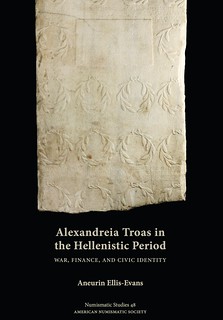 The American Numismatic Society is pleased to announce the release of an exciting new publication in our Numismatic Studies series: Alexandreia Troas in the Hellenistic Period: War, Finance, and Civic Identity.
The American Numismatic Society is pleased to announce the release of an exciting new publication in our Numismatic Studies series: Alexandreia Troas in the Hellenistic Period: War, Finance, and Civic Identity.
This book uses the best but least exploited evidence we have for Alexandreia Troas—its coinage—to explore the city's Hellenistic history and the reception of that Hellenistic past in the imperial period after the polis was replaced by a Roman colony under Augustus. Alexandreia was especially valued by the various states that contended for control of the Greek world in the Hellenistic period for its strategic location at a crossroads in the eastern Mediterranean. As a result, the fate and fortunes of this community were tied to the shifting geopolitics of the Hellenistic world to an unusual degree. In the relative absence of other evidence, it is the coinage of Alexandreia that allows us to reconstruct the city's complex relations with external powers, to trace the community's struggle as a newly founded polis to define its place in the Greek world, and to understand how the city's Hellenistic past was rewritten in the imperial period.
For any questions about the book please contact publications@numismatics.org, though orders should be placed directly with ISD for any US-based purchasers or Brepols for those living outside of the United States. ANS members are eligible for a 30% discount on this title and all other ANS publications.
For more information, or to order, see:
Alexandreia Troas in the Hellenistic Period
War, Finance, and Civic Identity
(https://www.isdistribution.com/BookDetail.aspx?aId=189447)
Alexandreia Troas in the Hellenistic Period
War, Finance, and Civic Identity
(https://www.brepols.net/products/IS-9780897227438-1)
NEW CHAPTER: NEW ZEALAND MEDALS 1860S-80S
Martin Purdy of Upper Hutt, New Zealand writes:
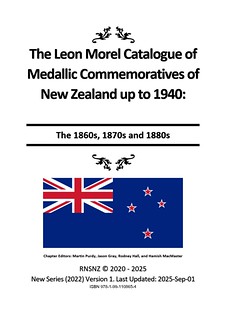 "Several months later than intended, the 1860s-80s chapter of the fully revised Morel catalogue of commemorative medals of New Zealand is online on my archive.org page at
"Several months later than intended, the 1860s-80s chapter of the fully revised Morel catalogue of commemorative medals of New Zealand is online on my archive.org page at
https://archive.org/details/@james_tigernuts, and in the RNSNZ repository at
www.RNSNZ.org.nz/collector-info/catalogues.
It can be downloaded from both sites, and can also be consulted and searched online as a flipbook on the archive.org page, along with the latest versions of the eight other chapters in the Morel and MacMaster medal catalogue series that have been released so far."
Here's the book's Introduction. -Editor
This is part of a projected multi-volume series updating Leon Morel's Catalogue of Medallic Commemoratives of New Zealand, 1865-1940 (1996) and the Supplement published in 2000. This new edition marks a departure from previous RNSNZ catalogue projects in that it is being released electronically in the first instance, and in sections. In this way, parts of the book can be published as they become ready and can also be regularly updated as new information becomes available.
The various sections of the catalogue will ultimately cover the whole of NZ's medallic history from the earliest issues associated with this country through to the Centennial events of 1940. More recent issues, from 1940 (not Centennial-related) to date, are being covered by a companion series, "New Zealand Commemorative Medals since 1940, New Series (2022)", also being published in parts and in electronic form.
Because these publications are being released as searchable PDFs, the previous Index of Legends has now been dispensed with as unnecessary.
To read the earlier E-Sylum articles, see:
NEW CHAPTER: NEW ZEALAND MEDALS - 1900S
(https://www.coinbooks.org/v26/esylum_v26n46a05.html)
NEW CHAPTERS: NEW ZEALAND MEDALS 1920S-30S
(https://www.coinbooks.org/v24/esylum_v24n50a04.html)
NEW BOOK: BANKNOTE STORIES
Anil Bohora has published a book related to banknotes titled "Banknote Stories". Congratulations. Here's the book's Introduction. -Editor
 Every banknote tells a story. There is visual interplay between the various elements on
the banknotes. In this way, a banknote resembles a well-rounded story that includes a
fascinating plot and characters.
Every banknote tells a story. There is visual interplay between the various elements on
the banknotes. In this way, a banknote resembles a well-rounded story that includes a
fascinating plot and characters.
A banknote is a representation of a country in a miniature format. If we look closely enough, banknotes of the world tell us interesting stories of the time they were printed and used, places, politics, culture, and history. Banknotes feature mythical creatures, local heroes, national treasures, or natural wonders, but sometimes they also feature unintended design elements.
One of the most important features of banknotes is that people need to trust them. Banknotes have played a critical role in shaping the global economy, acting as a medium of exchange for transactions. These pieces of printed paper hold immense power, as they serve as a symbol of trust in financial systems worldwide.
In this book some of the topics I have covered include banknotes reflecting the impact of hyperinflation, banknotes with hidden messages and secrets, banknotes with a difference, different materials used to make banknotes, banknotes telling us war stories, banknotes as works of art; etc.
The book is well written and illustrated, with stories of interest to beginning and advanced collectors alike. Topics include inflation notes, hidden messages and symbols, the world's largest banknotes by size and denomination, design errors, odd denominations, banknote materials (including Walrus skin and playing cards), currency symbols, short snorters, Prisoner of War scrip, time-based currency, and the only convicted forger in the world depicted on a banknote. -Editor
To download the book for free, see:
https://foxly.link/BanknoteStories
NEW BOOKS: THE ALMIGHTIER, MAKING MONEY WORK
The Museum of American Finance Newsletter for September 25, 2025 highlights two recent books on the nature and future of money. See also the article on Tally Sticks elsewhere in this issue for another look at the ancient creation of money. -Editor
In The Almightier, journalist Paul Vigna uncovers the forgotten history of money, tracing the uneasy and often accidental alliance between wealth and religion as it developed from ancient city-states to today's secular world, where religious devotion has receded and greed has stepped in to fill the void. Through engaging anecdotes, original research, and fresh perspectives on the causes of the many challenges we face today, Vigna makes a compelling argument that money has no power apart from the power we give it.
For more information, or to order, see:
The Almightier
(https://us.macmillan.com/books/9781250343284/thealmightier/)
The Almightier: How Money Became God, Greed Became Virtue, and Debt Became Sin
(https://www.amazon.com/Almightier-Money-Became-Greed-Virtue/dp/1250343283)
In Making Money Work: How to Rewrite the Rules of Our Financial System, Matt Sekerke and Steve H. Hanke deliver a rigorous and fascinating exploration of the monetary economy. You'll find a detailed and clear roadmap of how and why fiat money is created and destroyed, its connections to the broader economy, and the objective mechanisms that underwrite and maintain its value.
In their exploration, Sekerke and Hanke solve many problems and puzzles and shed light on several important questions...
For more information, or to order, see:
Making Money Work: How to Rewrite the Rules of Our Financial System
(https://www.wiley.com/en-us/Making+Money+Work%3A+How+to+Rewrite+the+Rules+of+Our+Financial+System-p-9781394257270)
Making Money Work: How to Rewrite the Rules of Our Financial System
(https://www.amazon.com/Making-Money-Work-Rewrite-Financial/dp/1394257260)
BOOK REVIEW: THE ROMAN PROVINCES, 300 BCE–300 CE
Mike Markowitz published a review of Andrew Burnett's book, The Roman Provinces, 300 BCE–300 CE: Using Coins as Sources. -Editor
 The Roman Provinces, 300 BCE–300 CE: Using Coins as Sources
The Roman Provinces, 300 BCE–300 CE: Using Coins as Sources
by Andrew Burnett
Cambridge: Cambridge University Press, 2024. Pp. xlii, 362. Illus., maps, chron., sidebars, appends., biblio., index. $39.99 paper. ISBN:1009420100
Using Local Coinage for Insights into Provincial Life and Society
In the urbanized, largely Greek-speaking cities of the eastern half of the Roman Empire, hundreds of towns issued their own small change, mostly in copper alloy. Small change was a big problem in the ancient world; imperial authorities went to great pains to ensure a supply of precious metal coins to pay the troops, but the needs of an urban economy, where people need to make daily small purchases to survive, were often neglected.
Numismatists (the people who study coins) call these low-value coins "Greek Imperial" or "Roman Provincial," and since they are usually quite affordable, they have gained growing interest among collectors in recent years. Frankly, they are not much to look at. They are seldom great works of the engraver's art, and they are rarely well-preserved. But they often depict local landmarks, myths and legends and many honor obscure members of the imperial family with portraits that are charmingly crude.
Cambridge University Press, in collaboration with the American Numismatic Society in New York, is publishing a series of handbooks called "Guides to the Coinage of the Ancient World." Among numismatists there is a proverbial expression: "Buy the book before you buy the coin." This lavishly illustrated (in color!) volume demonstrates the wisdom of that saying.
The book is organized chronologically in seven chapters:
- "Precious Metal Coinages at Rome and in the Provinces"
- "The Beginnings of an Empire in Italy and the Western Mediterranean"
- "The Growth of an Empire during the Late Republic"
- "Whose Coins? A Model for City Coinage in Imperial Times"
- "The Revolution of Augustus - and Becoming More Roman in the First Century"
- "Reinforcing Greek Identity in the Golden Age of the Second Century"
- "‘From a Kingdom of gold to One of Iron and Rust' in the Third Century"
Appendices include a comprehensive Numismatic Glossary, a summary of the denominations, and an explanation of how coins were produced.
The Roman Provinces will be an essential reference for classical numismatists, but will also be of interest to students of ancient economies.
The author, Andrew M. Burnett, (born 23 May 1952) is a British numismatist and museum curator. He was Deputy Director of the British Museum from 2003 to 2013, and Keeper of its Department of Coins and Medals from 1992 to 2003. He was president of the Royal Numismatic Society from 2013 to 2018.
To read the complete article, see:
Book Review: The Roman Provinces, 300 BCE–300 CE: Using Coins as Sources
(https://www.strategypage.com/bookreviews/2752)
To read the earlier E-Sylum article, see:
NEW BOOK: ROMAN PROVINCES, 300 BCE–300 CE
(https://www.coinbooks.org/v27/esylum_v27n49a05.html)
THE BOOK BAZARRE
2025 IAPN BOOK PRIZES AWARDED
The International Association of Professional Numismatists (IAPN) has presented awards for their 2025 book prizes. Congratulations to the winners and all entrants alike - publishing a numismatic book is an excellent achievement requiring months or years of effort. -Garrett
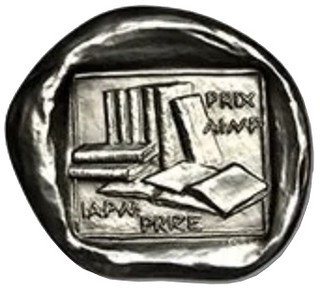 Since 1982, in order to encourage the publication of books of scientific and general interest, the International Association of Professional Numismatists (IAPN) has awarded an annual honorary prize for a numismatic work published the previous year. During the annual IAPN General Assembly, members hold a vote to select a winner from among the many titles submitted to the competition.
Since 1982, in order to encourage the publication of books of scientific and general interest, the International Association of Professional Numismatists (IAPN) has awarded an annual honorary prize for a numismatic work published the previous year. During the annual IAPN General Assembly, members hold a vote to select a winner from among the many titles submitted to the competition.
The IAPN Book Prize consists of a medal, a diploma and a monetary award of CHF 1,000 (Swiss Francs). Prize winners are formally presented with their awards during future IAPN gatherings.
Books suitable for the prize must be submitted to the Chairman of the Publication Committee at least 90-days before the General Assembly of the Association convenes.
Congratulations to Jean-Yves Kind, Winner of the 2025 IAPN Book Prize.
Jean-Yves Kind, the first prize winner, is an archivist and former special advisor on the Conservation of Treaties at the Ministry of Foreign Affairs. He has managed the French coin collection at the National Library of France since 2009. His book catalogues an important part of the extraordinary collection of French royal gold coins found in his Institution. This comprehensive collection covered in two volumes includes gold coins issued from the reigns of Louis IX to Louis XVI, featuring many extremely rare and unique specimens.
KIND, Jean-Yves. Catalogue des Monnaies Royales Françaises. 1: Monnaiesd'or Louis IX à Louis XII; 2: Monnaies d'or François Ier à Louis XVI2 vols. Bibliothèque Nationale de France/Éditions V. Gadoury, Monte Carlo, Monaco, 2024
ISBN 978-2-90660-256-4
Price: €95. Order at https://www.gadoury.com/en/books/catalogue-des-monnaies-royales-francaises-tome-i-et-ii.
Second prize went to CARBONE, Lucia. Local Coinages in a Roman World: Second Century BC First Century AD2 vols. American Numismatic Society, New York, 2024
ISBN 978-0-89722-419-2 and 978-0-89722-420-8
Price: US $325. Order at https://numismatics.org/store/rbw/.
Third prize went to VANHOUDT, Hugo, and SAUNDERS, John. The Gold Coinage of the Low Countries Hugo Vanhoudt, Heverlee, NL, 2024
ISBN 978-1-73565-981-7
Price: €100. Order from vanhoudt.hugo@gmail.com.
Submission Requirements for the next IAPN Book Prize:
- All books must have a 2025 imprint.
- All nominations to be sent by email to the Chairman of the Publication Committee by Friday, 30 January 2026.
- The deadline for submissions of physical books to the Chairman is Friday, 20 February 2026.
To read the complete article, see:
The IAPN Book Prize
(https://www.iapn-coins.org/book-prize)
To read the earlier E-Sylum articles, see:
NEW BOOK: CATALOG OF FRENCH ROYAL GOLD COINS
(https://www.coinbooks.org/v27/esylum_v27n23a04.html)
NEW BOOK: LOCAL COINAGES IN A ROMAN WORLD
(https://www.coinbooks.org/v27/esylum_v27n28a03.html)
NEW BOOK: GOLD COINAGE OF THE LOW COUNTRIES
(https://www.coinbooks.org/v27/esylum_v27n17a03.html)
For the complete list of 2025 winners and nominees, see:
2025 IAPN BOOK PRIZES ANNOUNCED
(https://www.coinbooks.org/v28/esylum_v28n26a05.html)
2024 IBNS BOOK OF THE YEAR RESULTS
In other book awards, here are notable paper money books recognized by the International Bank Note Society in their Book of the Year awards. This annual award started in 1979. Thanks to Roland Rollins for passing this along. Thank you! A lot of great book here, too. -Editor
NEIL SHAFER 2024 BOOK OF THE YEAR RESULTS
PHILIPPINE EMERGENCY AND GUERRILLA CURRENCY OF WORLD WAR II (SECOND EDITION 1)
-Matthias Voigt, Kenneth Berger & Neil Shafer
s
Ahrensburg, Germany (2024)
GUERNSEY PAPER MONEY – A COMPLETE HISTORY
-Pam West & Steve Norman
Amersham, England (2024)
ENGRAVERS AND PRINTERS OF CONFEDERATE PAPER MONEY
-Mark A. Coughlan, Orlando, FL
U.S.A. (2024)
Banknotes Salvaged, Looted, or Lost from Shipwrecks (Updated 2024)
- Roland Rollins,
Oklahoma City, OK U.S.A. (2024)
Catalogue of Macedonian Banknotes
– Zoran Strezoski (translation: Jovan Strezoski)
Skopje, Macedonia (2024)
Mehilba World Replacement (3rd edition)
– Dr. Ali Mehilba,
Monee IL, U.S.A. (2024)
Paper Dreams in the Golden State (A History of California Through Its Paper Money)
– Dennis Hengeveld, Stacks Bowers Galleries,
California, U.S.A. (2024)
Paper Money of Scotland (Updates & Amendments)
– Jonathan Callaway and Dave Murphy
Amersham, England (2024)
Provincial Russian Notes of the Revolution and Civil War 1917-1923
– Alan M. Cole, Spink Books,
London, U.K. (2024)
Siam Specimen Banknotes Third Series
– Jan Olav Wilborn Aamlid, House of Coins
Thailand (2024)
The Signers and Issuers of Confederate Bonds
– Charles Derby and Michael McNeil, CC&A, LLC
Colorado, U.S.A. (2024)
The Complete Catalog of UNESCO World Heritage Sites on Banknotes (Updated)
– Roland Rollins
Published only in E-book format (2024)
For more information on the International Bank Note Society, see:
https://www.theibns.org/
To read the earlier E-Sylum articles, see:
NEW BOOK: PHILIPPINE EMERGENCY CURRENCY 2ND ED.
(https://www.coinbooks.org/v27/esylum_v27n18a03.html)
NEW BOOK: GUERNSEY PAPER MONEY
(https://www.coinbooks.org/v27/esylum_v27n12a05.html)
BOOK REVIEW: CONFEDERATE ENGRAVERS AND PRINTERS
(https://www.coinbooks.org/v27/esylum_v27n27a06.html)
NEW BOOK: BANKNOTES FROM SHIPWRECKS, 2024
(https://www.coinbooks.org/v27/esylum_v27n29a08.html)
NEW BOOK: MACEDONIAN BANKNOTES
(https://www.coinbooks.org/v28/esylum_v28n02a06.html)
NEW BOOK: PAPER DREAMS
(https://www.coinbooks.org/v27/esylum_v27n45a03.html)
NEW BOOK: PAPER MONEY OF SCOTLAND
(https://www.coinbooks.org/v21/esylum_v21n09a09.html)
2025 IAPN BOOK PRIZES ANNOUNCED
(https://www.coinbooks.org/v28/esylum_v28n26a05.html)
NEW BOOK: SIGNERS AND ISSUERS OF CONFEDERATE BONDS
(https://www.coinbooks.org/v27/esylum_v27n27a04.html)
NEW BOOK: UNESCO WORLD HERITAGE BANKNOTES
(https://www.coinbooks.org/v27/esylum_v27n10a03.html)
COGAN LEVICK SALE CATALOG EDITIONS
The latest addition to the Newman Numismatic Portal is an alternate edition of the J.N.T. Levick auction sale catalog. Project Coordinator Len Augsburger provided the following report. -Editor
Editions of the Edward Cogan Levick Sale Catalog (1859)
Lara Jacobs, the Internet Archive scanner working at ANS under sponsorship of Newman Portal, recently called to our attention an alternate edition of the J.N.T. Levick auction sale catalog. We were previously aware of a 976-lot post-sale, priced edition. Lara located an unpriced, 973-lot version in the ANS library. The Levick collection represented Cogan's fifth sale; the previous four catalogs are all known by post-sale, priced editions produced by Attinelli.
The Gengerke and Adams bibliographies are the first resources to consult. Adams reports the 973-lot version, however, his 2001 errata notes "Should be 976 lots." Gengerke noted only the 976-lot version. This writer's copy of the Attinelli bibliography is best described as "6 over 3," in which case the printer seems to have etched a 6 over the final digit of the lot count. However, Attinelli makes an important clarification: "This catalog was reprinted after the sale with the prices printed in," the key word being reprinted. The confirms the two versions of the catalog.
The catalogs differ in several respects. There are different covers, and the printer's name is given on the earlier version but not the final version. There are a few anomalies (typos?) in the earlier version, including lot 30, which is not present. Lots 627 and 907 have multiple listings. An 1840 proof half cent (lot 505 in the final version) is not present in the pre-sale edition. For the Levick sale, this earlier, 973-lot version is considerably scarcer. A contemporary collector would have found the post-sale, priced edition more useful and would have had little reason to preserve the original. Indeed, besides the ANS copy, we could find only a single instance of the 973-lot version, from Kolbe 67 (October 1996), lot 554. Kolbe noted in part "lots priced in pencil with buyers' names and other annotations, including listings of several additional lots sold at the sale."
A final clarification is that the 976-lot version comes in both "large paper" and regular size formats. A complete set is thus comprised of three separate editions. Thanks to Dan Hamelberg, David Hill, and Jim Neiswinter for assistance in preparing this note.
David Fanning adds:
"See Kolbe Sale 83, lots 709-713, where George discussed the existence of both versions of the catalogue.
"We had a copy of the 973-lot version in Sale 110, lot 225. It's almost certainly true that the post-sale priced version with 976 printed lots is the more common of the two."
Link to J. N. T. Levick catalog (post-sale priced edition):
https://nnp.wustl.edu/library/auctionlots?AucCoId=19&AuctionId=511989
Link to J. N. T. Levick catalog (pre-sale edition, ANS copy):
https://archive.org/details/pricedcatalogueo00coga_21
VIDEO: PNG LIVING HISTORY: Q. DAVID BOWERS
The David Lisot Video Library on the Newman Numismatic Portal can be found at:
https://nnp.wustl.edu/library/multimediadetail/522852
We highlight one of his videos each week in The E-Sylum. Here's one from 2009 with Dave Bowers talking about about the great collectors he has known. -Editor
Dave Bowers is one of the most prolific writers in numismatics as well as being involved many of the great coin sales over the last 50 years. His name is synonymous with auctions, rare coins and great collectors. He shares the story of his career in numismatics and some of the tales of many of the great collectors he has known.
To watch the complete video, see:
PNG Living History: Q. David Bowers, August 7, 2009
(https://youtu.be/hI25gxyquQs)
PNG Living History: Q. David Bowers, August 7, 2009
(https://nnp.wustl.edu/library/book/560396)
BREEN, BASHLOW, SHELDON AND THE X-FILES
M. Dlugosz chanced across a two-year-old YouTube video with 1950s references to numismatic figures Walter Breen, Robert Bashlow, William Sheldon and G-Men in Black. -Editor
Dlugosz writes:
"The video was an interview conducted by Danny Jones - he's a seasoned podcaster with a focus on controversial topics, UFOs and physics among them.
"The subject being interviewed is theoretical physicist Dr. Jack Sarfatti
https://en.m.wikipedia.org/wiki/Jack_Sarfatti
"When I heard Dr. Sarfatti mention Bashlow and numismatics and then shortly after, Breen and Sheldon, I was stunned.
"What follows are brief details to the most mind-boggling tangentially numismatic tale you'll hear this century."
Here's the video so everyone can listen themselves. I'll be interested to hear what people think. Some out-there things are alluded to in this very rambling interview, but when talking about Bashlow and Breen, Sarfatti mostly comes across as relating first-hand experiences as a high school student.
For more on the Columbia superkids project, see Pete Smith's earlier series on Bashlow, linked below. -Editor
Dlugosz continues:
"Controversial figures / numismatists Walter Breen, William Sheldon, and Robert Bashlow are connected to Roswell, UFOs, and CIA precursors through an interview with theoretical physicist Dr. Jack Sarfatti.
"In the linked interview Sarfatti recounts a 1950s program identifying highly intelligent children for placement in special cohorts, led by Sheldon and managed by Breen, aimed at nurturing future science and math leaders.
"The children, evaluated and guided toward specific universities, occasionally met men in black suits who discussed communism, UFOs, and were tested for psi abilities, as summarized in this YouTube comment for E-Sylum readers."
Summary of content:
- 14:17 Sarfatti meets Robert Bashlow
- 15:02 Bashlow introduces Sarfatti to Breen, 86th/Lexington apartment
- 15:28 Breen manages 1950s program under Sheldon for gifted kids, allegedly through Columbia. (29:47: program financed by Eugene McDermott.)
- 16:16 Men in black suits from New Mexico discuss UFOs, communism, test kids for psychic abilities.
- 16:57 Breen as "Scout Master."
- 19:28 Alan Greenspan in Sheldon/Breen gifted kids cohort.
- 21:58 Breen, USAF, at Roswell 1947; claims intellect enhanced by non-human intelligence/tech.
- 23:00 Breen completes Johns Hopkins degree in one year while enlisted. Bruce Vogel holds Breen's manuscripts (17:45)—see Vogel for details.
- 23:30 Jack studies at Cornell with Manhattan Project professors. Background: British Intelligence in Ivy League, OSS/CIA ties. Sarfatti, lead tenor, Cornell's Gilbert and Sullivan Society.
- 27:40 The Good Shepherd connection/mention.
- 29:46 McDermott/Sheldon link.
- 29:50 The Good Shepherd, OSS/CIA.
To watch the complete video, see:
CIA Funded Physicist Exposes Mind-Driven UFOs, Warp Drive & Time Travel | Jack Sarfatti
(https://www.youtube.com/watch?v=70Vrvg4dUHQ&lc=Ugzjkm8x50Z6NUSMbA14AaABAg)
To read the earlier E-Sylum articles, see:
ROBERT BASHLOW, PART ONE
(https://www.coinbooks.org/v25/esylum_v25n18a15.html)
ROBERT BASHLOW, PART TWO
(https://www.coinbooks.org/v25/esylum_v25n19a16.html)
ROBERT BASHLOW, PART THREE
(https://www.coinbooks.org/v25/esylum_v25n20a13.html)
MORE ON THE 16TH 1804 DOLLAR PROVENANCE
Doug Ward submitted these additional thoughts on the provenance of the 16th 1804 dollar. Thank you. -Editor
More on the 1804 Dollar Provenance
Thanks to John Dannreuther for his further commentary. I believe we agree in principle. I have one question that's been a sticking point for me. I have read a number of articles which recounted the "two heavy trunks in a wagon" story (or was it three?), but I have not seen any documents or written account of this incident. Maybe John or others have such information? I doubt it occurred, since auction appearance records do not reflect the continued introduction of patterns to the market place after 1885, or the 1892 Woodside auction. This, despite that more than 400 patterns had not appeared until after 1910. Also, without a substantial Mint hoard as a trade, why would Mr. Woodin return the Half Unions to the Mint? Documentation confirmed that the Treasury department dropped its interest in them when their claims were reduced to off-metal patterns.
Provenance Post Script
The fate of a significant coin collection consisting of cherished mementoes representing one's earthly exploits is usually handled by an auction company these days. Thus, the perceived maximum return on investment can be extracted and the proceeds distributed amongst heirs. This can be done in either the present life or posthumously. In the event of an untimely demise, the arrangements are orchestrated by an executor.
Such was the case in the settlement of Dr. Linderman's estate and dissemination of his collection of pattern pieces. Among his trophies was a Class III 1804 Dollar. He undoubtedly played a central role in the propagation of this enigma, including its sisters. The sale of his collection is well known and was messy, and finally came in 1888 after its seizure and a legal brawl that severely tarnished the reputation of the Director and his family. His wife was likely forced to lie, specifically regarding the origin of Dr. Linderman's infamous dollar dated 1804. It would stretch credibility to believe he had bought it from the same dealer whom he, or more likely his protégé Col. Snowden, had relied on to sell them.
While in restly repose, Dr. Linderman would be oblivious to the consternation his unsettled exploits had caused his dear wife and family. Such would not be the case for Col. Snowden, who surely filed away the unsavory events for future reference. After his employment with the Treasury Department, he moved on to the State Department and elevated his stature amongst the political and societal elite. Reputed to be a talented orator, he further leveraged his social skills after departing the Mint in 1885. In 1887, he was chosen to be the Marshal of the Centennial celebration of the United States Constitution. During the early 1890's, his family would enjoy the perks of his ambassadorships to Greece, Romania, Serbia and Spain. His daughters and son would marry further into social circles.
U. S. Minister A. Louden Snowden and his son Charles Randolf Snowden (right) with William Sachtleben in front of the U. S. Embassy, Athens, Greece, March 12 th , 1891. (Image courtesy of UCLA Library Digital Collections.)
As his grandchildren were born and grew up in this privileged backdrop, and Col. Snowden enjoyed the fruits of his labor and loins, he was seemingly haunted. Ghostly visitations were not only by the fate of his mentor's collection and family, but also by the prophetic words of W. Elliot Woodward, a prolific dealer and trusted fence. His advice in 1863, came with the sale of four 1862 ‘God Our Trust' patterns and the "strict injunction that they must never be sold, unless by a sheriff or executor." It is strangely possible that these were actually Col. Snowden's own words, or those of his mentor, coming back to haunt him. In any event, it's evident he decided against his executor and leaving the fate of his trophies, mementoes and family to chance and Treasury authorities. He would sell his collection. All he needed was a sheriff and a plan. Enter Edgar H. Adams and what transpired as the Great Pattern Plot.
1862 Ten-dollar Eagle ‘God Our Trust' pattern struck in copper, J297. (Image from the Eric P. Newman Collection, Part 1, courtesy of the Newman Numismatic Portal and Heritage Auctions.)
This scenario was not lost on researcher Walter H. Breen, who's words regarding other numismatic accumulations were lost on most subsequent researchers and writers. In 1952 he would write for The Numismatist:
"The above completes the listing of hoards in the proper sense of the word, at least of those hoards about which information has been available to me. It will be noticed that I have omitted all mention of so-called hoards which were really accumulations for numismatic purposes. This takes care of the so-called "South Shore hoard" of cents, as well as the Snowden hoard comprising unsold numismatic materials including thousands of patterns, restrikes and mules and similar pieces de caprice, along with material like the 1873-cc dime without arrows. (This last seems to have been a leftover from the February 1874 meeting of the Assay Commission? … and recall that the only pieces the Carson Dity mint had to send to Philadelphia were assay coins.) This Snowden accumulation left the mint about 1909 in settlement with Mr. Woodin for the two $50 pieces in gold."
As previously mentioned, lost amongst this vast menagerie was a Class III 1804 Dollar. 115 years later, none of the fifteen known can be attributed to Col. Snowden, whom otherwise is linked to most Mint emissions of pattern, trial and experimental pieces produced from the mid-1860's onward.
The reverse die unique to Class II and all Class III specimens, is shared by the Stack coin. Its characteristics include rust marks, specifically on and around the left upright of the U in UNITED. The reverse die was destroyed in 1860, limiting the Class III coins to those already struck. The obverse die was destroyed in 1869 with no other known impressions. As with the other Class III specimens, the Stack coin must be cupped. All were subsequently edge lettered using the Castaing machine sometime after their striking.
In 1869, a Class III 1804 Dollar was first offered to collectors, likely placing their edge lettering under the dominion of Col. Snowden. This would indicate that he and Dr. Linderman had first pick of available specimens, since the condition of both seems similar and the best among those known. Indeed, the condition of the Linderman coin is estimated to be PR63, and the grade of the others becomes lower with subsequent acquisition date. Although graded PR65, who had real control may be further revealed by the edge lettering on the Stack coin. The edge lettering on the Linderman coin is described as blundered.
The 1885 Snowden pattern dollar struck in aluminum, J1749. Edge lettering was intended to deter counterfeiting. (Courtesy of USPatterns.com and Heritage Auctions.)
Class III 1804 Dollar Origins
1. 1868 or 1869: Dr. Linderman – acquired from the Mint – est. PR63.
2. 1868 or 1869: William Idler – acquired from Capt. Haseltine, who was sworn to secrecy – est. PR60.
3. 1875: sold by a Vienna auction house – an early fencing ploy by Capt. Haseltine? – est. PR55.
4. 1876: Phineas Adams – acquired from Capt. Haseltine – PR58.
5. 1877: Robert Colton Davis – acquired from Capt. Haseltine – est. PR40.
6. 1893: James W. Ellsworth from W. Julius Driefus with strange & dubious early history – est. PR40.
Of the original Class III 1804 Dollars owners, William Idler's is the earliest reported acquisition, possibly occurring around 1868. In 1908, Capt. Haseltine described the coin as having been owned by Mr. Idler for forty years and that he was sworn to secrecy. In 1875, a specimen surfaced with a Vienna auction house, presumably an early fencing ploy. In 1876, Capt. Haseltine exhibited another that was then sold to Phineas Adams. Famed and first pattern cataloguer Robert Colton Davis bought another from Haseltine in 1877. Linderman's piece was certainly acquired earlier and was in his collection when he died in 1879. The sixth and last to surface appeared in 1893 with evidence of circulation and no clear earlier owner.
One hundred and thirty-one years later, the sixteenth specimen now appears – Fantastic No. 16. Without and in lieu of further evidence to the contrary, it would seem to have originated from none other than Col. Snowden.
In his final reckoning and effort to dispose of all vestiges of his clandestine labors, it is possible he passed No. 16 along to his kin. They in turn would have secretly or anonymously sold it to Mr. Stack. But given their tumultuous experiences, it seems unlikely No. 16 could have been kept secret, even as a sole and sovereign remembrance. His son Charles was killed in an automobile accident less than six months after his death and his eldest daughter experienced a divorce and a broken family. Col. Snowden could not have known these experiences and thus, have willed No. 16 to his youngest daughter, whom it seemed would go on live a relatively quiet life. Most importantly, none of Col. Snowden's many other numismatic trophies and mementoes appear to be attributable to his heirs.
It is rather more probable that an 1804 Dollar followed his other treasures through numismatic channels. Where better to leave No. 16, than with his newly found partner in transgression? The same partner he would trust with the liberation and sale of many of his other treasures and the volumes of inside information that were a testament to his other-life? Having spawned their vast majority, in a strange way patterns were his second family and kin. In his seminal pattern catalog, Mr. Adams did not credit Col. Snowden for the substantial information he undoubtedly contributed in first-hand reports and rarity accounting. Surely this anonymity was stipulated by Col. Snowden, who did everything possible to otherwise avoid any association with the Pattern Plot of 1910. Since his involvement and Mr. Adams' plot had taken 112 years to fully reach the light of day, it is of little wonder that No. 16 took a little longer.
Interestingly, Col. Snowden did go on to perfect his edge lettering technique, which was demonstrated for mass production on the Snowden Design dollar of 1885.
To read the earlier E-Sylum article, see:
MORE ON THE 16TH 1804 DOLLAR PROVENANCE
(https://www.coinbooks.org/v28/esylum_v28n38a13.html)
NOTES FROM E-SYLUM READERS: SEPTEMBER 28, 2025
More on the 16th 1804 Dollar Provenance
Rich Kelly writes:
"I've been enjoying reading the latest edition of The E-Sylum and stopped at the further report on the 16th appearance of an 1804 dollar. John Dannreuther mentions our names in contribution to the nefarious actions of Archibald Snowden in that writing, and had forgotten the date of that column in The Numismatist. Without repeating that column here is the gist of it:
"The column, dated August 2013, and entitled "Milking the Mint Connection" does mention the production of an 1804 dollar, which apparently appeared at a major coin auction in New York City on November 17th, 1869. The gentleman who presented the coin (not for sale) was said by mint employees to be present in a press room at night with Snowden and may have been secretly using a coining press with restored old dies. An investigation later ensued, but nothing was proven.
"Anyway, there is more information in this column on Snowden's questionable activities, and we thank John for bringing our column to the fore."
Thank you. -Editor
To read the earlier E-Sylum article, see:
MORE ON THE 16TH 1804 DOLLAR PROVENANCE
(https://www.coinbooks.org/v28/esylum_v28n38a13.html)
Black Continental Army Soldier Robert Freeman
Joseph E Boling writes:
"... who hath served in the Connecticut Line of the Continental Army,..." I cannot read those words without losing my composure.
This is in reference to an article mentioning a lot in the September 20, 2025 Early American History Auctions sale. -Editor
Another lot documents a Black soldier, Robert Freeman, who served in the Connecticut Line of the Continental Army, Revolutionary War, a pay order signed "X" with his mark, The "Valley Forge Muster Role Project" records Robert Freeman as a private, with the 8th Connecticut Regiment. serving at Valley Forge Camp
To read the earlier E-Sylum article, see:
EARLY AMERICAN HISTORY SEPTEMBER 2025 SALE
(https://www.coinbooks.org/v28/esylum_v28n37a18.html)
The Founding of the Visa Credit Card System
Vic Mason writes:
"I was delighted with the story of Bank of America's founding of the Visa credit card system and sent it to a friend who works for the bank in Manhattan.
"Great question for Trivia games: Who founded Visa, when and where?"
To read the earlier E-Sylum article, see:
BANK OF AMERICA'S FRESNO EXPERIMENT
(https://www.coinbooks.org/v28/esylum_v28n38a29.html)
Wanted: Graham's Reeded Edge Half Dollar Book
New subscriber and NBS member Philip Kotsios writes:
 "I have been collecting Reeded Edge half dollars and I need the book
"A Registry of Varieties of Reeded Edge Half Dollars, 1836-1839" authored by Dick Graham. I have been unable to locate one to buy for many months looking.
"I have been collecting Reeded Edge half dollars and I need the book
"A Registry of Varieties of Reeded Edge Half Dollars, 1836-1839" authored by Dick Graham. I have been unable to locate one to buy for many months looking.
"If a reader has one and isn't using it or knows of someone selling one, please get in touch with me at 978-995-6586 or mdpsk@hotmail.com."
I thought I had one of these for a hot minute, but no - I have the book on Reeded Halves by Jim Koening. If anyone knows where to find a copy of the Dick Graham book, please let Philip know. -Editor
For more information, see:
Capped Bust Half Dollar, Reeded Edge (1836-1839)
(https://coinweek.com/capped-bust-half-dollar-reeded-edge-1836-1839-coinweek/)
On the 1853-O No Arrows Half Dollar
Rich Kelly writes:
"In relation to the recent notations on the 1853 O half dollar (sans arrows and rays), it is a wonder if other tail dies were used to produce this rarity, because in the research of the history of the New Orleans mint we found that New Orleans cancelled 6 head and 24 tail (!) dies in May of 1853 - of the old standard. Makes us wonder about the high mintmark decision of the recent submission."
Thank you. Interesting possibility. -Editor
To read the earlier E-Sylum articles, see:
1853-O NO ARROWS HALF DOLLAR AUTHENTICATION
(https://www.coinbooks.org/v28/esylum_v28n37a07.html)
NOTES FROM E-SYLUM READERS: SEPTEMBER 21, 2025 : The Finest Known 1853-O No Arrows Half Dollar
(https://www.coinbooks.org/v28/esylum_v28n38a15.html)
Compliments on the Latest E-Sylum
Harry Cabluck writes:
 Highest compliments on the latest E-Sylum!
Highest compliments on the latest E-Sylum!
Perhaps one of the most informative of any past edition. Jam-packed with stimulating information, video and illustrations. Wow!
The excellent book review by Jeff Garrett of Mike Moran's "When Coins Were King" was top-notch.
Jeff truly prompts one to buy the book:
"rich in detail including the fact that senators were well into their cups, in fact, embarrassingly drunk, in the early morning voting that restored the silver dollar as legal tender currency in 1878."
"In the ensuing struggle, Mike presents the story in easily understood terms. He points out that Saint-Gaudens missed a golden opportunity in March 1907 to do an end run around engraver Charles Barber at the Philadelphia Mint. He also…"
Thank you - I enjoyed that issue as well. -Editor
To read the earlier E-Sylum article, see:
NEW BOOK: WHEN COINS WERE KING
(https://www.coinbooks.org/v28/esylum_v28n38a05.html)
2025 ANA PHILANTHROPY AWARD
Jeff and Mary Lynn Garrett have received the 2025 ANA Philanthropy Award. Here is the press release. -Garrett
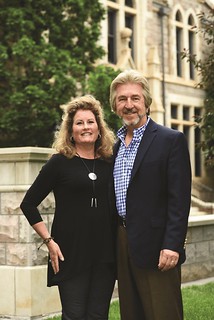 The American Numismatic Association's (ANA) Philanthropy Award publicly honors those who have made significant contributions to the Association that further its strategic mission to expand, enhance, and sustain the hobby of coin collecting. This year, the ANA recognizes Mary Lynn and Jeff Garrett for their many years of hobby support.
The American Numismatic Association's (ANA) Philanthropy Award publicly honors those who have made significant contributions to the Association that further its strategic mission to expand, enhance, and sustain the hobby of coin collecting. This year, the ANA recognizes Mary Lynn and Jeff Garrett for their many years of hobby support.
Mary Lynn and Jeff Garrett are passionate champions of numismatics and long-standing supporters of the ANA. Mary Lynn, a life member of the ANA for over 32 years, has served three terms as a governor (2019-25), is the current ANA vice president (2025-27), and has contributed to numerous ANA committees. A cofounder of the Bluegrass Coin Club in Lexington, Kentucky, she is deeply committed to educating future generations of collectors. Her leadership has helped shape young numismatists, some of whom are now professionals in the field.
Mary Lynn and Jeff serve as vice president and president of Mid-American Rare Coin Galleries, respectively. Jeff, an ANA past president (2015-17), began collecting coins as a child after being inspired by a Whitman Lincoln cent folder. He now brings over 50 years of professional experience to the organization and continues to supports its growth through education, strategic leadership, and fundraising. Both Mary Lynn and Jeff have attended countless conventions and Summer Seminars, emphasizing the value of shared knowledge and connection.
Together, the Garretts are strong advocates for expanding ANA membership, promoting planned giving, and strengthening the ANA's educational outreach. Their enduring dedication reflects their belief that numismatics is not only a hobby, but a lifelong journey of learning and community.
THE 2025 NATIONAL STOCK CERTIFICATE SHOW
The National Stock & Bond Show is coming to Virginia in January. Here's the announcement. -Editor
The 39th Annual National Stock & Bond Show to Convene in January 2026
The organizers of the National Stock Certificate & Bond Show are pleased to announce that the 39th Annual Show will be held on Friday, January 23, and Saturday, January 24, 2026, at the Crowne Plaza Hotel – Dulles Airport, Herndon, Virginia. Recognized as the premier event in the United States devoted to the field of scripophily, the show attracts collectors, dealers, and scholars dedicated to the preservation and study of historic stock and bond certificates.
The two-day event will feature leading dealers and exhibitors offering rare and historically significant securities from a wide range of industries and eras. Attendees will have the opportunity to acquire collectible certificates, engage with experts in the field, and learn about the history of American and international finance through original documents.
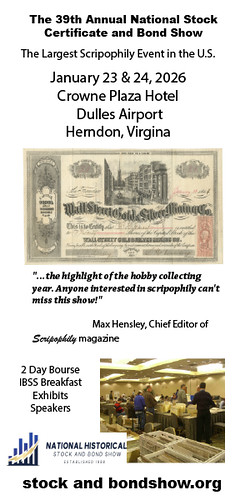 We have a growing list of exciting exhibits to include:
We have a growing list of exciting exhibits to include:
Museum of American Finance will be exhibiting a rare Loan Office certificate issued to and signed by George Washington, a Loan signed by Patrick Henry and Alexander Hamilton's Report on the Public Credit
Other Exhibits to include:
- Ticker Tape Machines and Ticker related stock certificates
- Certificates of Edison Companies
- Historical document and certificate Framing
Others to be announced
The program will also include the International Bond and Share Society Member Breakfast, scheduled for Saturday, January 24, at 7:45 a.m., which will feature a guest speaker. Expanded exhibit space in the hotel's Grand Ballroom has been secured to accommodate additional displays and provide enhanced opportunities for education and exchange.
A special hotel rate of $125 per night has been arranged for attendees. Reservations must be made by January 9, 2026, and guests should reference the "Stock and Bond Show" when booking accommodations.
"The National Stock & Bond Show has long served as the central gathering place for our community," said Scott Winslow, Show Organizer. "As interest in scripophily continues to expand globally, we remain committed to providing a venue that brings together collectors, dealers, and historians to share knowledge and preserve financial history."
For further information, exhibitor inquiries, or media requests, please contact:
Scott Winslow
Email:
scott@scottwinslow.com
Telephone: (603) 235-494
For more information about the International Bond and Share Society, see:
https://scripophily.org/
VOCABULARY TERM: ROLLING MILL
Here's another entry from Dick Johnson's Encyclopedia of Coin and Medal Terminology. -Editor
Rolling Mill. A machine with multiple rollers through which metal in plate or ingot form is rolled back and forth to reduce its thickness to a required size, creating strips for blanking. Rolling mills have developed dramatically over their history but the concept remains constant, to reduce metal thickness. The rollers – of solid steel – are often stacked and rotate in opposite directions so a second pass needs only to be fed into a set of rollers above or below the set previously used (with an operator on each side of the mill). The number of passes is dependent upon the desired thickness, the original thickness and the hardness of the metal. Rolling work hardens the strip, which must be annealed or softened before blanking and sometimes before additional rolling.
By this continuous rolling action a thick ingot can be reduced to long strips of controlled thickness in a manner of minutes. The mill can be set to control the width of the strip as well as the thickness, thus the length of the strip becomes elongated. The thickness difference between the in-going strip and the out-going strip is called the draft.
Formerly most strips for blanking coin and medal blanks were cold-rolled (in contrast to iron and steel mills which employ hot-rolling). Recently the hot rolling process has been adapted for rolling clad coinage strips. In addition to a desired thickness and width, rolling also provides a desired smooth surface of the metal from the polished surface of the rollers. Modern mills have gauges that continuously monitor the thickness and shut off when the desired gauge is reached. For coinage blanks, this prescribed thickness is called thickness strip and a different thickness strip is required for each denomination coin.
Parts of the rolling mill. These include the housing of the rollers (as a three-high blooming mill has three sets of rollers). The rollers are smooth steel drums and when stacked, say three high, the center roller is used with the adjacent roller. There are also straightening and cooling tables (where the strip extends between passes), slitters (where the strip is cut lengthwise), cutoff shears, coilers and decoilers (for rolling up and unwinding the strip); roll grinders and gauges. The rollers are run by heavy duty flexible direct current motors.
Today a typical clad coinage strip roll is 1,000 feet in length, and weighs between 3,000 and 7,000 pounds. Modern blanking presses accept this strip and with multiple blanking heads cut out as many as thirty blanks with each cycle of the press – the number of blanking dies determine the width of the strip and the number that can be blanked at one time.
History of the rolling mill. Leonardo da Vinci was the inventor of a primitive rolling mill and published this in his sketchbooks in 1495. Thirty years later Renaissance artist Benvenuto Cellini used a rolling mill to roll lead for lead seals he struck for Pope Clemente VII (1523-34). Other goldsmiths in central Europe, like Cellini, used rolling mills and were the first to develop machines beyond these primitive mills. They needed thin strips of precious metal for their work (and even used rolling mills to make the first clad gold strips – rolled gold).
The first rolling mills for blanking of coins was developed by Max Schwab (1550) in Augsburg, Germany, along with an improved screw press he developed. The French ambassador at Augsburg learned of this equipment and was instructed to procure these for King Charles V's mint in Paris. A worker at the Lyons mint, Aubin Olivier, was sent to Augsburg, instructed to learn these machines and return with them to Paris. He arrived 31 January 1551 with a rolling mill, draw plates, a blanking press and the screw press that Schwab had improved and built.
These were placed into use at once, and by 1552 blanking was accomplished in France by Antoine Brulier. Attempts to improve the rolling mill in this period were mixed. Nicholas Briot, first at the Paris Mint (1606-25), then at the London Mint (1633) and finally at the Edinburg Mint (1635-39) worked on the rolling mill as part of his attempted coinage by roller die (taschenwerke). Despite these early attempts, this form of coinage blank manufacture was in wide use with improved mills during the 1700s.
By 1787 Matthew Boulton was producing strips and blanking in quantity at his metal plants and Soho Mint in Birmingham. Joseph Bramah, also a manufacturer of Birmingham, had perfected his rolling mill and was supplying these to Boulton. Later, Henry Maudslay was manufacturing rolling mills following the establishment of his firm, Maudslay, Sons & Field (1810), along with other specialized mint tools, and later, counting machines.
By the mid 1800s Ralph Heaton was manufacturing rolling mills for coinage mints. Since then rolling mills have been manufactured in many industrialized countries by numerous firms (they are so widely used in the metalworking field).
In Boston Paul Revere built his own rolling mill about 1790, the first such rolling mill in America. He used this for his silversmith craft, but found it useful for other metals as well.
When coins were first produced by a blow to hand-held dies, this form of production was called hammered. With the introduction of the rolling mill and striking by the screw press, the process was called mill and screw, milled coinage, or simply milled. These terms were derived from the rolling of metal by the rolling mill prior to blanking. This form of metal processing has been in use from 1550 and every mint since then has required the use of a rolling mill if they do their own production of blanks. All struck coins since then have been milled. In truth, no struck coin or medal could have been made without the use of this equipment in the last 450 years!
Types of mills. Early metalsmiths used only one rolling mill to reduce thick metal into thin (often in combination with drawing plates). In the 19th century, mills were created to accommodate ingots of virtually any thickness. These first-step mills were developed in England and called breaking-down mills. (Americans shortened the term to break-down mill.
An ingot would be filed smooth on all sides (deburred) and swaged (flattened) on one end (the British called this step "topping.") The end that was flattened was fed between highly polished solid steel rollers; it would reduce the metal thickness and the newly stretched strip would emerge on the opposite side of the mill.
Perhaps three or four passes between these rollers could be accomplished before the strip could become so work hardened further rolling would be pointless. Special heat treating ovens were developed with long canisters to contain the strips to heat and gradually cool the metal to soften it. The strips could then be rolled again or blanked as needed.
Ultimately a second type mill was developed, a finishing mill. These rolled the strip to a precise thickness and often had gauges attached to the mill to automatically measure the thickness; when a precise gauge was reached it would halt the rolling at a precise gauge. Thus thickness strip could be easily produced in the finishing mill, then taken to the blanking presses.
To read the complete entry on the Newman Numismatic Portal, see:
Rolling Mill
(https://nnp.wustl.edu/library/dictionarydetail/516674)
IVAN CHARLES MICHELS (1829-1906)
E-Sylum Feature Writer and American Numismatic Biographies author Pete Smith submitted this article on author Ivan Charles Michels. Thank you. -Editor
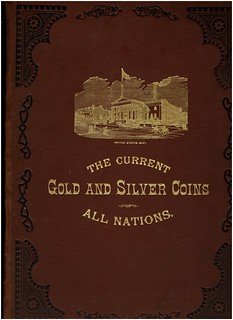 This week I pulled out a 145-year-old book to hold in my hands rather than read it on the
Newman Numismatic Portal. Sorry Len! I was interested to find the source of a story about the
1804 Dollar that was quoted in several newspaper accounts.
This week I pulled out a 145-year-old book to hold in my hands rather than read it on the
Newman Numismatic Portal. Sorry Len! I was interested to find the source of a story about the
1804 Dollar that was quoted in several newspaper accounts.
As a service for those who don't want to bother pulling out the book, I will quote It here. This is taken from a book by Ivan C. Michels published in 1880, The Current Gold and Silver Coins of All Nations… The full title runs 19 lines in the front of the book. My 1884 copy is noted as the fifth edition.
"This dollar has become exceedingly scarce, and the last sale of a fine specimen was made at one thousand dollars a piece. Of this dollar, according to returns of United States Mint records, 19,570 pieces were struck, and with the exception of a few, were all exported to Africa to pay the soldiers and sailors engaged in the war against Tripoli. On the 10th of June, 1801, the bashow of Tripoli declared war against the United States; but no further notice was taken of the declaration until 1803, when Commander Preble was sent to Tripoli with a large squadron. On the 31st of October, 1803, Captain Bainbridge was sent into the harbor of Tripoli to reconnoitre. His vessel. The "Philadelphia," of 44 guns, advanced too far in eager pursuit of a small Tripolitan gunboat, and struck on a rock. The officers were treated as prisoners of war, but the crew were made slaves. In 1804, Lieutenant Stephen Decator was ordered to recapture the "Philadelphia," which he promptly accomplished. As it was impossible to take her out, she was set on fire and abandoned. Soon after, Tripoli was bombarded several times by the U. S. ships of war. In 1804, an expedition was started from the United States against Tripoli, headed by Captain Eaton and Hamet Carmanly, exile and elder brother of the bashaw of Tripoli. Their march lay across a thousand miles of desert; yet it was accomplished, with indescribable fatigue and suffering, in fifty days. To pay the expenses of this little army of mounted Arabs and seventy American seamen, these 1804 dollars were shipped to the coast of Africa, and only very few of them, if any, were brought back by the returned victor. A few years ago ten pieces of the 1804 Dollars were struck from the old original sites at the U. S. Mint in Philadelphia and distributed. All but two or three were afterwards called in by order of our government, and to this day the coin cabinet of the Philadelphia Mint exhibits one 1804 Dollar struck in 1804, and another with the same date, but of the later issue."
Another version of this story is used to explain the disappearance of half eagles of 1801.
I thought to check on the reliability of Michels by seeing what he had to say about the 1792 half disme.
"This is popularly supposed to represent the features of Martha Washington, who is said to have sat for the artist while he was designing it. The coin is said to have been struck from the private plate of Washington, which is not unlikely, considering the great interest he took in the operation of the infant mint, visiting it frequently, and personally superintending many of its affairs."
It is obvious that the book required a lot of research and access to Mint records. There is no bibliography or list of sources. Perhaps comparison to previous sources will turn up matches.
Thus the Michels book should not be considered a reliable source of information but rather an amusing time capsule of the state of numismatic knowledge in 1880.
Ivan C. Michels was born in St. Petersburg, Russia, in 1829, and graduated from the University at St. Petersburg at age twenty-one. His father was also Ivan Charles Michels of French ancestry. His mother was Anna Damidoff of Russian ancestry.
Ivan came to America in 1856 as a correspondent for publications in Russian, French and German. He was a specialist in economics and statistics.
Michels published United States Druggists Directory first for 1859-1860. His address was 274 South Third Street in Philadelphia.
In 1863, he published Philadelphia Coal Oil Circular. An ad stated that he "has travelled over every continent on the globe and is master of seven languages."
Michels lived in New York during 1869-1875 and worked as an editor while living at 49 Cedar.
In April 1870, he was sued for libel by the publisher of another German language newspaper.
In 1870, while living at 49 Cedar Street, Michels was the publisher of Druggist's Price Current. He was also proprietor of a small German language Sunday paper, Die Laterne von New York.
In September 1870, Michels was elected president of the German Legal Aid Society of New York.
On Monday, October 10, 1870, four large men entered his office and attacked him with a club. They were scared off by his pistol shot. They were upset about the newspaper coverage of their insurance company.
In July 1875, Michels filed a suit against the Postmaster over an increase in postal rates. He lost the case.
For years prior to 1875, Michels collected translations of The Lord's Prayer into the various languages of the world. He had a goal of a thousand languages but by 1875, he had only acquired 814 languages. In 1876 he exhibited a manuscript that had 500 translations. For this he was awarded a medal at the 1876 Philadelphia Exposition.
In 1878 (The year the first Morgan Dollars were struck) he went to India to study the effects of American silver purchases. He returned after a year in India and China.
In 1883, he ran an ad in Frossard's Numisma, from P. O. Box 1636 in Philadelphia. He was looking to buy numismatic publications.
In 1885 he was elected secretary for the National Bi-Metallic Association executive committee and provided statistics to support the free-silver movement. He later changed his mind and worked against the movement.
Michels produced an 1887 pamphlet on The "True Cause of the Decline in the Prices for Wheat and a Remedy". This supported a proposal or the free coinage of silver.
In 1888 he was official statistician of the United States senate committee of mines and mining. He was frequently quoted on production figures for gold and silver.
Ivan married Elisabeth Sahler (1844-1929) in Manhattan on October 17, 1888.
A contemporary was an actress, Madame Ivan C. Michels, a/k/a Mary Ann Tyrrel (1812-1894).
Michels died at home at 109 E Street Northeast, Washington, D.C., after a lingering illness on March 16, 1906. He was cremated.
I searched the newspapers.com site with the keywords of "1804 Dollar" and Tripoli. There were many times the story was repeated after 1880 but none before. I am not aware of any source prior to 1880. The Philadelphia Press had a reaction to the story. "However, it is in print in Mr. Michels' book, and ought to be true."
HERITAGE: NETHERLANDS AND DUTCH COLONIES
Heritage Auctions will be hosting their Netherlands and Dutch Colonies Spotlight Sale on September 29. Select items are discussed below. -Garrett
Brabant. Albert & Isabella of Spain (1598-1621) gold 2 Ducats ND (1600-1611) MS62 NGC, Antwerp mint, KM11 (under Spanish Netherlands), Fr-84, Delm-142 (R). 7.00gm. ALBERTVS ET ELISABET DEI GRATIA. Confronted busts of Albert and Isabella / ARCHI AVST DVC BVRG ET BRAB Z. Crowned shield in collar of the Golden Fleece. A beautiful early 17th Century Spanish Netherlands gold type that our firm only gets the pleasure of handling every few years. Only a single example of the issue sits above the current selection on the NGC population records, a particularly impressive piece in such a quality Mint State assignment.
To read the complete item description, see:
Brabant. Albert & Isabella of Spain (1598-1621) gold 2 Ducats ND (1600-1611) MS62 NGC,
(https://coins.ha.com/itm/belgium/brabant/belgium-brabant-albert-and-isabella-of-spain-1598-1621-gold-2-ducats-nd-1600-1611-ms62-ngc-/a/61549-22009.s)
Holland. Provincial gold 6 Stuivers 1755 MS61 NGC, Dordrecht mint, KM45a, PW-Ho74.2, Delm-816 (R1). 6.93gm. The gold rendition of this "Scheepjesschelling" issue that retained the 6 Stuivers denomination of the original silver pieces but was struck to the weight of a double Ducat, though these were never intended for circulation. This is a particularly scarce date for the series, one that Heritage has yet to offer until now. Mint State examples such as this showing full mint bloom are especially popular with collectors.
To read the complete item description, see:
Holland. Provincial gold 6 Stuivers 1755 MS61 NGC,
(https://coins.ha.com/itm/netherlands/holland/netherlands-holland-provincial-gold-6-stuivers-1755-ms61-ngc-/a/61549-22051.s)
Thorn. Margaretha van Brederode gold Angelot ND (1557-1577) MS62 PCGS, Thorn mint, Delm-266 (R2), CNM-2.42.1, Fr-173f. 5.03gm. SA?CTVS: MICHAEL: ARCHA?GEL (double saltire stops), crowned, nimbate figure of St. Michael the Archangel standing facing with both feet on the Dragon (Satan), spearing with cross-tipped staff / MO?ETA: ?OVA: AVREA: THORENSIS (double saltire stops), cross-topped shield over ship, M-B to either side above. A stellar Dutch type that we rarely get the chance to handle, a faithful imitation of the Edward VI gold Angel issue this emission was inspired by. The present Mint State coin on offer shows a pleasing slate of details, though imperfect as expected. An exciting occasion for specialists of the issue or of imitative coinage in general.
Ex. Heritage Auction 3094 (August 2021, Lot 33268)
To read the complete item description, see:
Thorn. Margaretha van Brederode gold Angelot ND (1557-1577) MS62 PCGS,
(https://coins.ha.com/itm/netherlands/thorn/netherlands-thorn-margaretha-van-brederode-gold-angelot-nd-1557-1577-ms62-pcgs-/a/61549-22069.s)
Utrecht. Provincial 1/2 Ducaton (1/2 Silver Rider) 1774 MS65 PCGS, Utrecht mint, KM115.1, Delm-1055. An exemplary specimen of this "Half Crown" sized Silver Rider issue. The coating of frost imparted onto the surfaces at the mint is still fully intact and the multi-tonal iridescence is vibrant and beautiful. A rare Gem offering that would make an incredible type example for the iconic Silver Rider in this size.
To read the complete item description, see:
Utrecht. Provincial 1/2 Ducaton (1/2 Silver Rider) 1774 MS65 PCGS,
(https://coins.ha.com/itm/netherlands/utrecht/netherlands-utrecht-provincial-1-2-ducaton-1-2-silver-rider-1774-ms65-pcgs-/a/61549-22092.s)
Utrecht. Provincial gold 2 Ducat 1754 MS62 NGC, Utrecht mint, KM42.2, Delm-962, Fr-283. 7.00gm. By Joh. E. Novisadi (Mintmaster) and Cornelis van Swinderen. Knight standing to right with sword over his shoulder in his right hand and a bundle of arrows in his left hand; date divided to either side / MO:ORD:/ PROVIN:/ FOEDER:/ BELG: AD/ LEG:IMP. Inscription within ornate square frame. Dutch Double Ducats older than the Batavian Republic or often associated with shipwrecks such as the Vliegenthart or Akerendam, so this 1754 piece is quite desirable, especially in the Mint State assignment found here.
To read the complete item description, see:
Utrecht. Provincial gold 2 Ducat 1754 MS62 NGC,
(https://coins.ha.com/itm/netherlands/utrecht/netherlands-utrecht-provincial-gold-2-ducat-1754-ms62-ngc-/a/61549-22113.s)
Kingdom of Holland. Louis Napoleon 50 Stuivers 1807-(Bee) MS64 NGC, Utrecht mint, KM28, Dav-228, Schulman-148 (RR). Mintage: 300. By F. George. Slant-Reeded edge. NAP. LODEW. I. KON... Head right / KONINGRIJK HOLLAND. Crowned 4-fold arms divides value, date below The rare first-year issue of this coveted two-year Louis Napoleon series minted during the Kingdom of Holland period. An important entry in the Dutch "Crown" series that is challenging in such an excellent Mint State grade.
To read the complete item description, see:
Kingdom of Holland. Louis Napoleon 50 Stuivers 1807-(Bee) MS64 NGC,
(https://coins.ha.com/itm/netherlands/kingdom-of-holland/netherlands-kingdom-of-holland-louis-napoleon-50-stuivers-1807-bee-ms64-ngc-/a/61549-22148.s)
HERITAGE: ERROR US COINS SHOWCASE
Heritage Auctions will be hosting their Error US Coins Showcase auction on September 29. Select items are discussed below. -Garrett
1804 1/2 C Half Cent, Plain 4, No Stems, C-13, B-10, R.1 -- Flipover Double Struck in Collar -- MS63 Brown NGC.
From The Siesta Key Collection.
To read the complete item description, see:
1804 1/2 C Half Cent, Plain 4, No Stems, C-13, B-10, R.1 -- Flipover Double Struck in Collar -- MS63 Brown NGC.
(https://coins.ha.com/itm/errors/1804-1-2-c-half-cent-plain-4-no-stems-c-13-b-10-r1-flipover-double-struck-in-collar-ms63-b/a/60482-53006.s)
1811 1C Large Cent, S-287, B-1, R.2 -- Double Struck, Second Strike 50% Off Center -- VF30 PCGS.
From The Siesta Key Collection.
To read the complete item description, see:
1811 1C Large Cent, S-287, B-1, R.2 -- Double Struck, Second Strike 50% Off Center -- VF30 PCGS.
(https://coins.ha.com/itm/errors/1811-1c-large-cent-s-287-b-1-r2-double-struck-second-strike-50-off-center-vf30-pcgs/a/60482-53021.s)
1918 1C Lincoln Cent -- Struck 9 Times -- Fine 15 ANACS. Mintage 288,104,634.
From The Siesta Key Collection.
To read the complete item description, see:
1918 1C Lincoln Cent -- Struck 9 Times -- Fine 15 ANACS. Mintage 288,104,634.
(https://coins.ha.com/itm/errors/1918-1c-lincoln-cent-struck-9-times-fine-15-anacs-mintage-288-104-634/a/60482-53039.s)
2000 1C Lincoln Cent -- Quadruple Struck; Second, Third, and Fourth Strikes Off-Center -- MS64 Red PCGS.
To read the complete item description, see:
2000 1C Lincoln Cent -- Quadruple Struck; Second, Third, and Fourth Strikes Off-Center -- MS64 Red PCGS.
(https://coins.ha.com/itm/errors/2000-1c-lincoln-cent-quadruple-struck-second-third-and-fourth-strikes-off-center-ms64-red-pcgs/a/60482-53106.s)
1945 10C Mercury Dime -- Broadstruck -- MS64 Full Bands NGC. NGC Census: (5/20). Mintage 159,130,000.
To read the complete item description, see:
1945 10C Mercury Dime -- Broadstruck -- MS64 Full Bands NGC.
(https://coins.ha.com/itm/errors/1945-10c-mercury-dime-broadstruck-ms64-full-bands-ngc-ngc-census-5-20-mintage-159-130-000/a/60482-53156.s)
1978 25C Washington Quarter -- Struck on 1C Planchet -- MS66 Red NGC. 3.11 grains. Mintage 521,452,000.
To read the complete item description, see:
1978 25C Washington Quarter -- Struck on 1C Planchet -- MS66 Red NGC.
(https://coins.ha.com/itm/errors/1978-25c-washington-quarter-struck-on-1c-planchet-ms66-red-ngc-311-grains-mintage-521-452-000/a/60482-53185.s)
GUT-LYNT AUCTION 22 COIN SELECTIONS II
The 22nd Gut-Lynt coin auction will take place on the first weekend in October, starting on the public holiday (German Unity Day) on 3 October 2025. For the first time, more than 5,000 lots will be offered over three auction days. October 5th's selections comprise of coins and medals from antiquity to the present day. We would like to present some of the highlights here. -Garrett
On Sunday, 5 October 2025, the Gut-Lynt auction will start at 9:00 a.m. (CEST). The spectrum of foreign coins and medals ranges from Afghanistan to Cyprus, with the usual mixed lots at the end of the section, and comprises more than 1,400 lots. Of particular note is a series from Spain and its colonies in excellent condition, the Habsburg series.

Lot 4275: Great Britain, Dollar, no date (1797-1799), Bank of England emergency issue, countermark on Peru 8 Reales 1794, rare, excellent, estimate €150

Lot 4739: Austria, Silver medal 1683, Commemorating the liberation of Vienna from the Turkish siege, Very fine-Excellent, estimate €200

Lot 5114: Russia, 10 kopecks 1801, Bitkin 86 (R3), extremely rare, very fine-excellent, estimate €500

Lot 5395: Czechia, Bunzlau, silver medal, no date, commemorating the restoration of the image of Mary. Mint master Jacob Wölker. Stamp by Salomon Scultet, handle mark, fields smoothed, very fine, estimate 150 euros
The online catalogue will be available from the beginning of September on the auction platform www.auktionen.gut-lynt.de. Please remember to register in good time if you wish to bid for the first time. We accompany each auction with exclusive highlights on Instagram @muenzen_gut_lynt. Our website www.gut-lynt.de also offers previews and reviews as well as up-to-date information on auction dates and delivery deadlines.
If you have any questions about the auction, we are happy to help: simply write to info@gut-lynt.de or call us on: (+49) 02156 4874819. We look forward to hearing from you.
PS: Gut-Lynt Auction 23 is scheduled for the first weekend of Advent, 29th and 30th November 2025. Just in time for St. Nicholas Day, you can treat yourself to a gift. If you would like to part with individual items or entire collections, please do not hesitate to contact us. We offer consignors favourable terms and our passion.
Note for non-EU customers: Due to customs regulations, it is unfortunately not possible to ship certain lots to non-EU countries.
As DHL has temporarily suspended parcel and goods mail delivery to the USA (as of 31 August 2025), shipments to the USA will be stored by us until parcel delivery is possible again. Alternatively, another shipping method, such as FedEx, can be selected, but at a higher cost.
FRANK ROBINSON 129TH AUCTION ANCIENTS
Here's the press release for Frank Robinson's upcoming sale. Always some interesting material. -Garrett
ANCIENT COINS FEATURED IN ROBINSON AUCTION
Dealer Frank S. Robinson's 129th mail and internet auction of Ancient and Early Coins will include 585 lots, low starting bids, and no buyer fee. LIVE BIDDING will take place beginning at 11 AM Eastern Time October 26 on the biddr.com website. (The deadline for pre-bidding will be October 25.)
Featured in this sale is a further segment of a major collection of Judaean and Judaic related material, highlighted by Judaea Capta Sestertius of Titus that is the plate coin in the Hendin standard reference.
Greek coins include a choice EF+ Armenian Tigranes II Tetradrachm; a classic Athenian "Owl" tetradrachm in choice quality; an EF Baktrian Tetradrachm of Euthydemos I; and an excellent run of Parthian coins.
Notable among Roman coins are an EF Pompey portrait denarius; a Choice EF Tiberius "Tribute Penny" Denarius; a choice AEF example of the rare Claudius Sestertius with equestrian statue reverse; an a Nero Sestertius with horsemen reverse, graded Choice EF/AEF.
Noteworthy too is a special section of Far East related numismatic literature.
The sale also includes early choice Irish coins from the dealer's personal collection; Chinese cash coins, Russian, Byzantine and other early coinages, group lots, literature, and a section of items offered at fixed prices.
Robinson holds about three auctions annually, and tries to offer a broad range of material for advanced collectors as well as bargain hunters. Catalogs are free; contact Robinson at Box 8600A, Albany, NY 12208; phone 518-482-2639; e-mail frank@fsrcoin.com. The full catalog is at his website, www.fsrcoin.com.
To read the earlier E-Sylum article, see:
ROBINSON AUCTION 129 NUMISMATIC LITERATURE
(https://www.coinbooks.org/v28/esylum_v28n38a04.html)
COINS OF THRACE'S WARRIOR KINGS
Mike Markowitz wrote an article in CoinWeek on the coins of Thrace's warrior kings. -Garrett
Thrace is a historic region in the southeastern corner of Europe, encompassing modern-day Bulgaria, the European part of Türkiye, and a small portion of northern Greece. Ancient Thracians were a warlike tribal people known mainly through the writings of their Greek neighbors and the magnificent tombs where their kings were buried. The Thracian Odrysian kingdom ruled much of the region from approximately 460 BCE until it was absorbed by the Macedonian king Philip II, the father of Alexander the Great, around 340 BCE. Odrysian cavalry served as scouts in Alexander's army. The Odrysian kings produced a fascinating series of coins that have been extensively studied by Bulgarian numismatists and other scholars in recent years.
Although intriguing, this coinage was of limited output and had a moderate impact on the overall pool of money in circulation in Thrace from the fifth century to the middle of the first century CE. The available statistical data demonstrate that such coinage should be regarded more as a powerful symbolic claim by the kings of Thrace rather than as a regular currency with economic value. The sequence of rulers and their coin issues remains uncertain in some cases.
Key Rulers and Their Coinage
The Odrysian kingdom was founded by Teres I, who ruled c. 460–445 BCE, uniting some 40 different tribes into a powerful state.
Sparadokos
His son, Sparadokos, who ruled c. 445–435 BCE, was the first Odrysian king to issue coins in his own name. His name is abbreviated as S?A ("SPA"). Three denominations in silver were struck, probably at the Greek city of Olynthus, which had extensive trade with Thrace. The diobol (about 1.5 grams) shows the front half of a running horse on the obverse and a flying eagle with a snake in its beak on the reverse.
Seuthes I
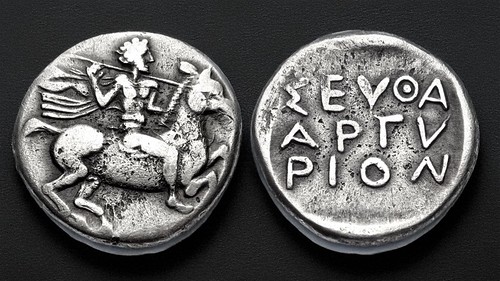
Seuthes I or II. c 424-405 BCE or 405-386 BCE. Silver Didrachm 8.56 g,. Topalov 71 the second known (the other in the Bibliotheque Nationale in Paris).
Seuthes I, who ruled c. 424–405 BCE, was a son of Sparadokos. Only about half a dozen silver coins in the name of Seuthes are known, and there is some uncertainty about whether they should be assigned to him or a later king of the same name, Seuthes II, who ruled c. 405–386 BCE. A cataloguer writes of Seuthes I that he:
is ingloriously remembered for ending the campaign of his uncle King Sitalkes in Macedon, after allowing himself to be bribed by the Macedonian king Perdikkas II. Thucydides speculated that Seuthes had a hand in the death of his uncle, to whose throne he succeeded in 424 BC. Yet, under his rule, the Odrysian kingdom grew to new heights of power and wealth.
A very rare silver didrachm (8.56 grams, only two examples known) bears a horseman brandishing a javelin, with the bold inscription SEYTA/APGV/PION ("Silver of Seuthes") on the reverse.
To read the complete article, see:
Coins Of Thrace's Warrior Kings
(https://coinweek.com/from-teres-to-seuthes-iii-unearthing-the-coins-of-thraces-warrior-kings/)
COIN FINDS IN GALILEE
Michael Kodysz passed along this Jerusalem Post article about a coin find in Galilee. Thanks. -Editor
A rare hoard of 22 copper coins dating back more than 1,600 years has been uncovered in a hidden underground complex in the Lower Galilee, offering a tangible link to the region's Jewish history under Roman rule, the Israel Antiquities Authority announced on Thursday.
The coins were unearthed in Hukok, an ancient Jewish settlement near the Sea of Galilee associated with Jewish resistance under Roman rule.
"The discovery of the rare hoard of coins in the Hukok hiding complex is a living testimony to the determination of the Jews of the Galilee and their ongoing struggle to maintain their identity and traditional Jewish lifestyle even in difficult times under Roman rule," said Israeli Heritage Minister Rabbi Amichai Eliyahu. "Finds of this type connect us directly to the lives of our ancestors and remind us of the depth of our historical roots here."
The coins were found in a pit at the end of a narrow winding tunnel within the Hukok hiding complex, one of the largest and most intricate underground networks in the Galilee. Originally carved during the Great Revolt of 66–70 CE and expanded for the Bar-Kochba Revolt of 132–136 CE, the tunnels were expected to yield artifacts from those periods. Instead, the coins bore the images of Emperors Constantius II and Constans I, dating them to the 4th century CE, during the lesser-known Gallus Revolt of 351–352 CE—the last Jewish rebellion under Roman rule.
The coin hoard will be presented for the first time this week at a conference hosted by Kinneret Academic College. A study of the findings is due to be published in the Israel Numismatic Research Journal.
To read the complete article, see:
Galilee cave yields 4th-century coin hoard tied to Jewish resistance under Rome
(https://www.jpost.com/archaeology/article-867877)
Peter Huntoon passed along another article about additional finds at the site. Thanks. -Editor
At the end of July 2025 a metal detector beeped wildly in Susita National Park, near the Sea of Galilee. Operator Eddie Lipsman, working with the University of Haifa expedition, moved the soil near a large stone and saw gold coins flash in the cut. "The detector went crazy; I couldn't believe it—gold coins began to be exposed one after another," said Lipsman. The team soon uncovered a hoard.
Researchers collected 97 gold coins and fragments of earrings set with pearls, semi-precious stones, and glass. The coins spanned the reigns of Justin I (518-527 CE) to the opening years of Heraclius (610-613 CE), placing them roughly 1,400 to 1,500 years old. Solidus pieces, halves (semissis), and thirds (trachy) were present, and the dig marked the first time such a hoard had been recovered in the city.
To read the complete article, see:
'The detector went crazy': Hoard found in Byzantine Christian center near Sea of Galilee
(https://www.msn.com/en-us/news/world/the-detector-went-crazy-hoard-found-in-byzantine-christian-center-near-sea-of-galilee/ar-AA1NglcI)
A third article has an image of the gold coins. -Editor
Archaeologists near the Sea of Galilee have discovered a rare, nearly 1,400-year-old hoard of gold coins and jewelry dating to the Byzantine era.
The hoard contained 97 pure gold coins and dozens of jewelry pieces, including earrings inlaid with pearls, semi-precious stones and glass. A team found the treasure while investigating the ancient city of Hippos (also known as Sussita), which is on the slopes of the Golan Heights.
"It is among the five largest gold hoards of that period found in the region," Michael Eisenberg, an archaeologist at the University of Haifa and co-director of the excavation, told Live Science in an email. "The addition of jewelry pieces and small currency makes it more interesting and numismatically important. It's the first of its kind in Hippos so far."
To read the complete article, see:
'Gold coins started appearing one after another': 1,400-year-old hoard with money and jewelry unearthed near Sea of Galilee
(https://www.livescience.com/archaeology/gold-coins-started-appearing-one-after-another-1-400-year-old-hoard-with-money-and-jewelry-unearthed-near-sea-of-galilee)
TALLY STICKS AND THE ORIGIN OF MONEY
An new study published in the Journal of Economic Issues shows that tally sticks were precursors of market economies and the invention of money. Here's an excerpt - see the complete article online. -Editor
When we picture the history of money, many imagine barter leading naturally to coins, then paper bills, then cards and digital balances. But new research led by University at Albany Anthropology Professor Robert M. Rosenswig shows that this familiar narrative doesn't hold up—and that lessons from ancient wooden and bone tally sticks matter for how we understand money today.
His conclusion: Orthodox economics, which treats money primarily as a medium of exchange, does not fit the evidence. Tally sticks, he argues, suggest that money originates with governments as a system of accounting and taxation.
Rosenswig's study, "Ancient Tally Sticks Explain the Nature of Modern Government Money," published in the Journal of Economic Issues, shows that tally sticks—independently invented in England, China and the Maya world—were consistently used by state officials to record and cancel tax or tribute obligations.
"The historical record shows that barter doesn't precede the creation of financial money," Rosenswig said. "Tally sticks remind us that money is not a scarce commodity but an accounting system rooted in political authority."
"Anthropologists have long demonstrated that barter was never a pre-monetary system," said Rosenswig. "Instead, barter appeared only in societies with existing monetary systems when formal currency was scarce or between strangers for one-off exchanges—not as the foundation of whole economies."
Tally sticks, he argues, show how states mobilizing resources through accounting systems backed by taxation, fitting into a broader pattern where different forms of money arose to meet different needs, from wampum beads in the Americas to Roman coins in Britain.
"What ties these cases together was not barter, but political authority to enforce obligations through accounting," said Rosenswig.
The current study compares how tally sticks were used across three very different civilizations.
To read the complete article, see:
Ancient tally sticks across three civilizations challenge myths about money
(https://phys.org/news/2025-09-ancient-tally-civilizations-myths-money.html)
To read earlier E-Sylum articles, see:
FEATURED WEB SITE
(https://www.coinbooks.org/esylum_v03n29a13.html)
MEDIEVAL TALLY STICKS AND HOW THEY WORKED
(https://www.coinbooks.org/v20/esylum_v20n29a26.html)
TALLY STICKS FOR MONEY
(https://www.coinbooks.org/v27/esylum_v27n34a19.html)
WAMPUM BEADS UNEARTHED IN NEWFOUNDLAND
Archaeologists working in Newfoundland have made the first discovery of wampum beads in that area of Canada. -Editor
Seven tiny beads unearthed in Newfoundland, Canada, are a rare discovery — they may be the only wampum ever found in the province, and they hint at trade between Indigenous people and European colonists.
The beads were found in July at the Colony of Avalon site in Ferryland, which was an early European settlement and a trading post for Indigenous people in the 17th century.
The tubular beads are white and purple, and they were crafted from the shells of whelk (carnivorous sea snails) and quahog (hard-shelled clams). They were unearthed by archaeology student Calum Brydon, who told CBC News that at first he didn't know what he had discovered. Minutes later, however, archaeologists in charge of the excavation recognized the beads as wampum.
"All the wampum beads were found in a 17th century midden [garbage] layer deposited inside a storage room associated with Ferryland's principal dwelling or Mansion House," archaeologist Barry Gaulton, a professor at Memorial University in St. John's, Newfoundland and Labrador, told Live Science.
Indigenous people often used wampum as currency with colonial settlers, but these beads may be the first wampum ever found in Canada's vast easternmost province.
"No wampum beads have been found at the Colony of Avalon in [more than] 30 years of ongoing archaeological investigation," Gaulton said in an email. "To the best of our knowledge, no wampum beads have ever been found in the province of Newfoundland and Labrador."
"Wampum" is an English settler term derived from the Algonquin word "wampumpeag," meaning "string of white shell beads." Many Indigenous people, especially in the eastern parts of pre- and post-Colonial North America, originally used wampum beads for ceremonial purposes: elaborate belts and necklaces made from wampum beads, for example, were used to record important events, such as treaties and declarations of war.
The style of the beads and their drilling method indicates they were made in about 1600. The beads "likely arrived at Ferryland in the 1640s or 1650s," Gaulton said. "Their discovery in a domestic midden dating from the mid- to late-17th century suggests that they were discarded or lost during this period."
To read the complete article, see:
Rare wampum beads discovered at 17th-century colony in Newfoundland
(https://www.livescience.com/archaeology/rare-wampum-beads-discovered-at-17th-century-colony-in-newfoundland)
LONDON DESIGN FESTIVAL BANKNOTE BENCHES
Artist Saskia Boersma's new London Design Festival pop-up, "Reconstructing Value," has turned £2.5 million in British banknotes into sculptural benches. -Garrett
If you've ever dreamed about sitting on a fortune, literally, you'll get a chance to do so at London Design Festival with the Bank of England Museum's newest pop-up, "Reconstructing Value". A collaboration between designer Saskia Boersma, the Surface Matter collective and the material studio Plasticiet transforms £2.5 million worth of withdrawn British banknotes into a series of sculptural benches that echo the pound sign (£) while questioning what we consider valuable .
The process begins with the systematic removal of old notes from circulation. Once shredded, the paper fibers are reconstituted using a proprietary plasticiser that binds the material without compromising its texture. The resulting sheets retain the iconic hues and subtle security patterns of the original currency, allowing the benches to retain a recognisable, yet abstract, financial language. Surface Matter then curates complementary surface palettes like roman mosaic tiles, Portland stone and patinated brass, mirroring the historic interiors of the Bank while reinforcing the dialogue between past and present .
Saskia Boersma's design language, known for its playful reinterpretations of everyday objects, frames the benches as both functional furniture and public art. Each piece is cast into a curved form that, when viewed from above, outlines the £ symbol, turning the act of sitting into a visual reminder of monetary flow. The benches occupy the museum's historic Stock Room, a space once reserved for vaults and ledgers, thereby redefining the room's purpose from storage to social interaction.
Beyond aesthetics, the project tackles the environmental impact of paper waste. By diverting millions of pounds of banknote paper from landfill, the installation demonstrates a circular economy model where discarded money gains a second life as design material. Plasticiet's plasticiser, a low-impact polymer, ensures durability while maintaining a tactile softness that encourages lingering. The initiative aligns with the London Design Festival's broader emphasis on sustainable innovation, positioning the Bank of England Museum as a laboratory for post-waste design solutions.
To read the complete article, see:
Reconstructing Value turns banknotes into benches
(https://www.yankodesign.com/2025/09/22/reconstructing-value-turns-banknotes-into-benches/)
THIEVES STEAL GOLD FROM MUSEUMS
Le Augsburger passed along this New York Times article about a theft of raw gold from a museum in Paris. Thanks. Here's an excerpt - see the complete article online. -Editor
Thieves broke into a gallery at the National Museum of Natural History in Paris overnight Monday and stole nuggets of raw gold worth about $700,000, officials said on Wednesday.
The theft occurred in the geology and mineralogy gallery, the museum said in a statement. The gallery includes meteorites, giant crystals, rocks, minerals and other specimens relevant to the history of the Earth and the solar system, the museum said.
The stolen pieces were taken from a display of unrefined gold, the museum said. The theft was detected by the museum's security personnel and is under investigation by the police.
Emmanuel Skoulios, the museum's director, told BFM TV, a French news broadcaster, that he viewed the stolen pieces as "invaluable" because of their historical and scientific significance.
"We are dealing with an extremely professional team, perfectly aware of where they needed to go and with professional equipment," Mr. Skoulios said in the interview.
The French news agency AFP reported that the thieves had used a blow torch and grinder to gain access.
Native gold refers to gold in its natural state, like that retrieved from streams in nugget form or extracted from the earth in crystalline form. Untouched by human hands, it is irregular in shape, and no two pieces are alike.
To read the complete article, see:
Thieves Steal $700,000 in Gold From Natural History Museum in Paris
(https://www.nytimes.com/2025/09/17/us/paris-museum-gold-theft.html)
The theft is part of an ongoing string of similar heists. -Editor
"This incident comes at a critical time for cultural institutions and museums in particular. Several public collections have indeed been targeted by thefts in recent months," the museum added.
It did not elaborate on the other robberies, but the Adrien Dubouche National Museum in Limoges in central France is known to have suffered a break-in earlier this month.
Thieves stole two dishes and a vase in Chinese porcelain classed as national treasures, with the losses estimated at 6.5 million euros. The museum holds around 18,000 works including the largest public collection of Limoges porcelain in the world, according to its website.
Last November, four men with axes and baseball bats smashed the display cases in broad daylight at the Cognacq-Jay museum in Paris, making off with several 18th-century works. That heist resulted in an insurance payment of over $4 million to the Royal Collection Trust, BBC News reported.
The next day, jewelry valued at several million euros was stolen during an armed robbery at a museum in Saone-et-Loire in central France.
To read the earlier E-Sylum article, see:
Gold worth $700,000 stolen from Paris' Natural History Museum amid string of similar heists
(https://www.cbsnews.com/news/gold-stolen-from-paris-natural-history-museum/)
LOOSE CHANGE: SEPTEMBER 28, 2025
Here are some additional items in the media this week that may be of interest. -Editor
John Feigenbaum of Whitman Brands was interviewed on PBS News Hour about the end of the U.S. cent. The segment was adapted to a Daily News Lesson for students. -Editor
The penny could soon be a thing of the past. President Donald Trump is pushing to end production of the one-cent coin, citing its rising costs. Each penny costs nearly four cents to make and scrapping it could save taxpayers about $56 million a year. Deema Zein discussed more with John Feigenbaum of Whitman Publishing, a leading producer of numismatic reference books.
To read the complete article, see:
Does it make sense to keep minting the penny?
(https://www.pbs.org/newshour/classroom/daily-news-lessons/2025/09/does-it-make-sense-to-keep-minting-the-penny)
In the found-while-looking-for-other-things department is this article forwarded by Aaron Oppenheim about people searching for German V-2 rockets in Poland who stumbled across a cache of coins, ornaments and silver ingots from the early Middle Ages. -Editor
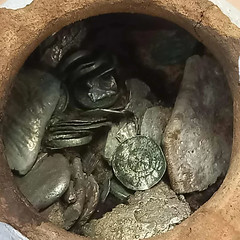 The first find, discovered by group member Hubert Piasecki on June 7, was a clay pot filled with treasure.
The first find, discovered by group member Hubert Piasecki on June 7, was a clay pot filled with treasure.
"[The pot was] filled with coins, ornaments and silver ingots from the early Middle Ages, containing 631 artifacts," Kurowiak said.
"These included cross denarii, foreign coins such as English ones (including from King Harold I of England), as well as German, Hungarian, Czech coins and others."
A few weeks later, on June 28, member Michal Makuch found a pot full of coins from the early Middle Ages.
Though it hasn't been opened yet, Kurowiak said the vessel is packed with silver coins, based on recent CT scans.
"And just when it seemed we couldn't get any luckier, we came upon another treasure – an incredible one, containing a gold necklace (222 grams of pure gold) from the Roman influence period, possibly up to 1,800 years old," he added.
To read the complete article, see:
Hobbyists searching for rockets accidentally unearth 'incredible' ancient treasures buried deep underground
(https://www.foxnews.com/travel/hobbyists-searching-rockets-unearth-incredible-ancient-treasures-buried-deep-underground)
In the you-just-can't-make-this-stuff-up department is this item from the Bruun Rasmussen Newsletter of September 18, 2025. -Editor
 Included in the auction is a cherished relic that marks an important event in the history of the Freetown of Christiania. The so-called "Regnbuetræf" medal was issued in connection with an event where the hippies at Christiania invited their counterparts, the "Leather Jackets," from Denmark, Sweden, Norway, and England, to a sort of reconciliation celebration in June 1976. The motto was the legendary Mao quote: "Align yourself with your worst enemy, and you will become invincible." However, the event did not turn out as a peaceful reconciliation meeting but ended in 50 hours of fire, smoke, and blood, as the 1,500 invited motorcyclists brought chaos to Christiania and other parts of Copenhagen.
Included in the auction is a cherished relic that marks an important event in the history of the Freetown of Christiania. The so-called "Regnbuetræf" medal was issued in connection with an event where the hippies at Christiania invited their counterparts, the "Leather Jackets," from Denmark, Sweden, Norway, and England, to a sort of reconciliation celebration in June 1976. The motto was the legendary Mao quote: "Align yourself with your worst enemy, and you will become invincible." However, the event did not turn out as a peaceful reconciliation meeting but ended in 50 hours of fire, smoke, and blood, as the 1,500 invited motorcyclists brought chaos to Christiania and other parts of Copenhagen.
FEATURED WEBSITE: COINS & HISTORY FOUNDATION
This week's Featured Website is The Coins & History Foundation, suggested by Loren Gatch. -Garrett
 The foundation's purpose is to share the passion for history and numismatics, to promote the hobby of collecting coins and medals to a wide audience, as well as to increase the knowledge and awareness of rare and historical coins, modern coins and medals.
The foundation's purpose is to share the passion for history and numismatics, to promote the hobby of collecting coins and medals to a wide audience, as well as to increase the knowledge and awareness of rare and historical coins, modern coins and medals.
The Coins & History Foundation is a registered Dutch foundation established by various key members of the numismatic world in order to support and promote a broader understanding of coins and currency, while also offering help and information about the collecting, display, and appreciation of coins. Our objectives are to:
- Support research in the areas of numismatics, archaeology and history through sponsorship of research projects, publications, exhibitions and congresses and issuing of scholarships.
- Support and encourage publications in the area of numismatics, archaeology and history, both those of high academic ambitions reaching a narrow audience and educational publications targeted for a wider audience.
- Support and encourage any activity that stimulate collections of coins and medals, in particular those that engage with a wider audience than the traditional numismatic societies, including young and new collectors.
- Support young designers and engravers of coins and medals through scholarship and sponsored design competitions.
- Help bringing together the various part of the numismatic industry, including scholars, collectors, dealers, mints and designers.
- Stimulate ethical and environmentally friendly sourcing of metals for production of coins as well as supporting ethically and environmentally friendly production methods.
The Coins & History Foundation is registered with the Dutch trade register (nl. Kamer van Koophandel) with KvK-number 77953827 and RSIN 861212071
Here is a video from the Coins & History Foundation on The Similar Sixpence Scandal of 1887: -Garrett
https://coinsandhistoryfoundation.org/
The British "similar sixpence" situation echoes the gold-plated 1883 "no cents" nickel affair here in the U.S. (which Pete Smith discussed in his article on columnist Mickey MacDougall. -Editor
To read the earlier E-Sylum article, see:
MICHAEL S. MACDOUGALL (1902-1996)
(https://www.coinbooks.org/v28/esylum_v28n38a17.html)
ABOUT THIS ISSUE: SEPTEMBER 28, 2025
This was a normal week as The E-Sylum goes. On Wednesday I sent several articles to Garrett to work on, and he returned them to me ready to go on Saturday afternoon.
For me, Saturday was a special occasion. This time last year, you may recall, I ran for the first time in the "5K on the Runway" race at Dulles Airport, only to hear later from my foot doctor that I shouldn't run anymore. Having been looking forward to running again, I was very disappointed. But a couple months ago I went back to the doctor, asking if I could pretty please run just this one race. He said "well, give it a try and we'll see how it goes". In January I'll see him again for an evaluation, but I ran the 2025 race.
I tagged along with neighbors again, a family of four and myself. We left the cul-de-sac just after 6am. The race started at 7:30. and while we waited near the starting line one of us took this photo of the lovely sunrise.
Last year we arrived later and at the very crowded beginning, I didn't even know where the starting line was - I figured it out and started running long after I'd passed it. I was more on the ball this time, and more confident having done the course once before. 2,500 runners entered, and I finished 1,027 overall. For an old guy (67) who'd barely run all year, I think it was a success. Being older than all but 30 of the other runners, I'm very happy with the result. I came in 25th in my age group of 47 male runners, and only one runner in the group older than me beat my time.
I chowed down on a second breakfast when I got home and started working on The E-Sylum. By mid-afternoon I was ready for a nap and did end up laying down for 20 minutes before heading out to a nice steak dinner with my family. As you can see, I ended up getting the issue out on time.
It's been a great quarter. We've had some really super issues, and we added two new sponsors - Douglas Winter Numismatics and Heritage Auctions. Thank you for your support!
While working on the issue Sunday morning, my household was watching our Pittsburgh Steelers play the Minnesota Vikings in Dublin, Ireland. Great game.
On the way out, here's an interesting non-numismatic article I came across this week. Tim Berners-Lee created the world wide web atop the new internet, and made it free for all, the same principle that inspired The E-Sylum.
Why I gave the world wide web away for free
(https://www.theguardian.com/technology/2025/sep/28/why-i-gave-the-world-wide-web-away-for-free)
-Editor
Wayne Homren
Wayne Homren is the founding editor of The E-Sylum and a consultant for the Newman Numismatic Portal. His collecting interests at various times included U.S. Encased Postage Stamps, merchant counterstamps, Pittsburgh Obsolete paper money, Civil War tokens and scrip, Carnegie Hero Medals, charge coins and numismatic literature. He also collects and has given presentations on the work of Money Artist J.S.G. Boggs. In the non-numismatic world he's worked in artificial intelligence, data science, and as a Program Manager for the U.S. Department of Defense.
Garrett Ziss
Garrett Ziss is a numismatic collector and researcher, with a focus on American paper money and early U.S. silver and copper coins. He is also a part-time U.S. coin cataloger for Heritage Auctions. Garrett assists Editor Wayne Homren by editing and formatting a selection of articles and images each week. When he's not engaged in numismatics, Garrett is pursuing a Master's Degree in Quantitative Economics at the University of Pittsburgh.
Pete Smith
Numismatic researcher and author Pete Smith of Minnesota has written about early American coppers, Vermont coinage, numismatic literature, tokens and medals, the history of the U.S. Mint and much more. Author of American Numismatic Biographies, he contributes original articles to The E-Sylum often highlighting interesting figures in American numismatic history.
Greg Bennick
Greg Bennick (www.gregbennick.com) is a keynote speaker and long time coin collector with a focus on major mint error coins and US counterstamps. He is on the board of both CONECA and TAMS and enjoys having in-depth conversations with prominent numismatists from all areas of the hobby. Have ideas for other interviewees? Contact him anytime on the web or via instagram
@minterrors.
John Nebel
Numismatist, photographer, and ANS Board member and Fellow John Nebel of Boulder, CO helped the ANA and other clubs like NBS get online in the early days of the internet, hosting websites gratis through his Computer Systems Design Co. To this day he hosts some 50 ANA member club sites along with our
coinbooks.org site, making the club and our E-Sylum archive available to collectors and researchers worldwide.
Bruce Perdue
Encased coinage collector (encasedcoins.info) Bruce Perdue of Aurora, Illinois has been the volunteer NBS webmaster from its early days and works each week to add the latest E-Sylum issue to our archive and send out the email announcement.
